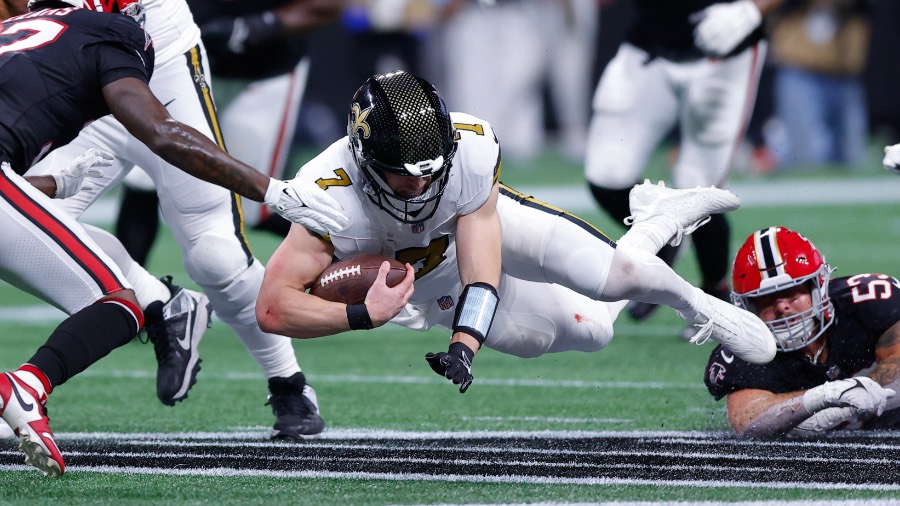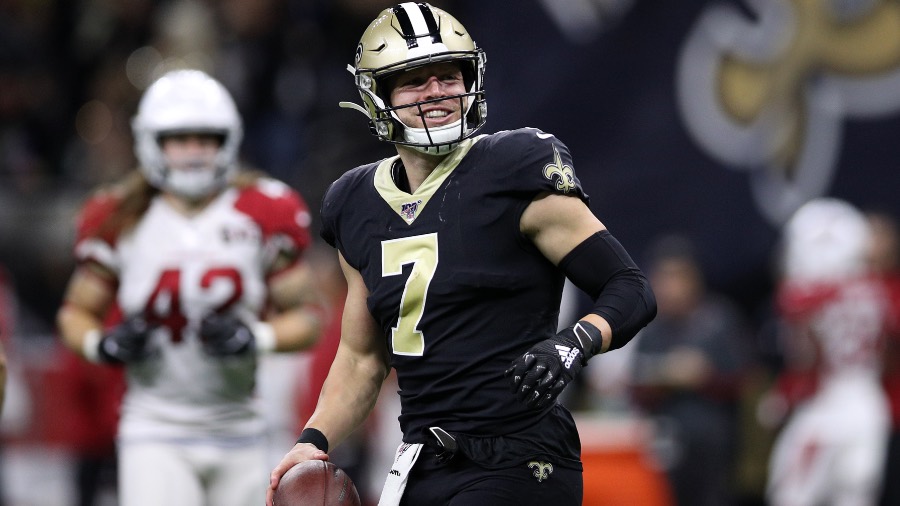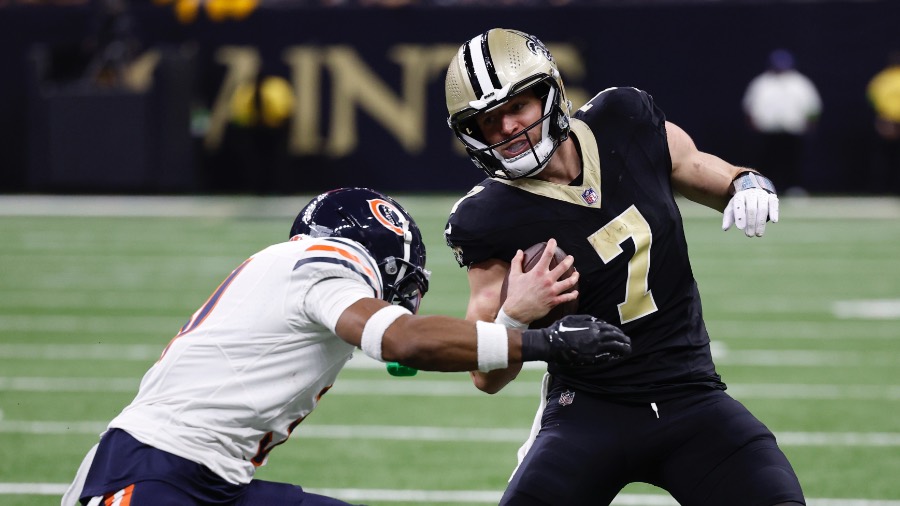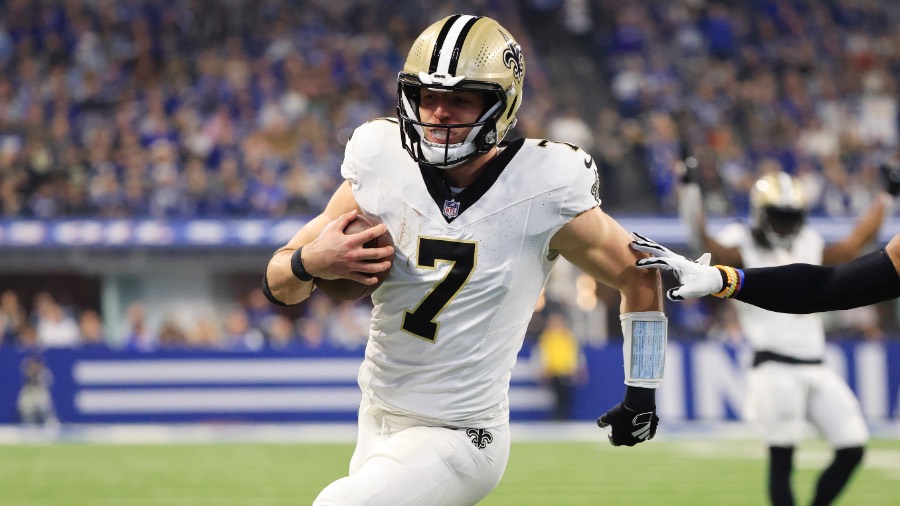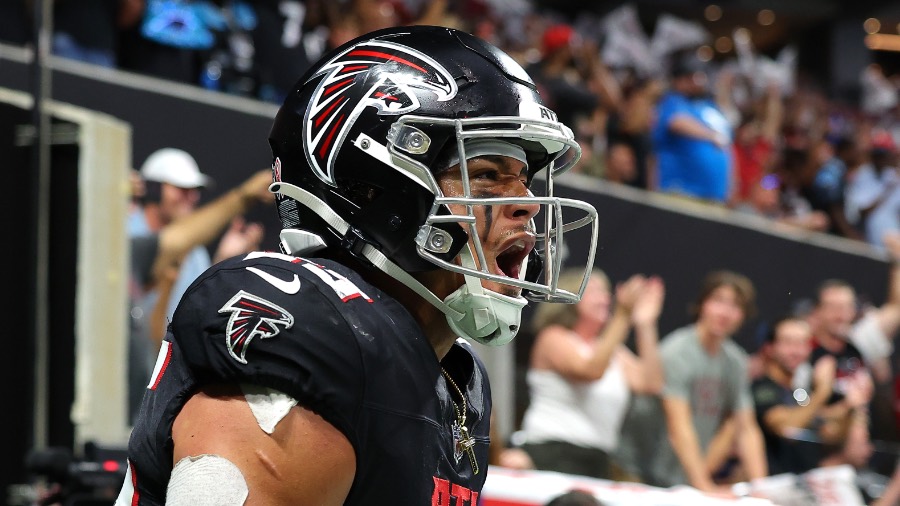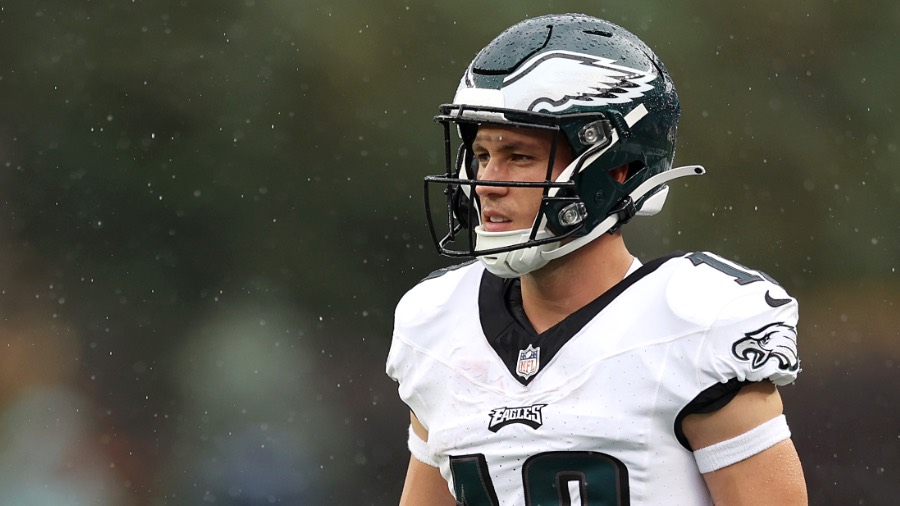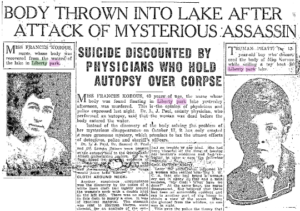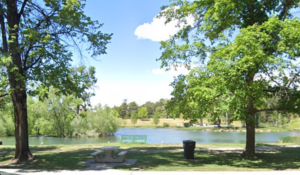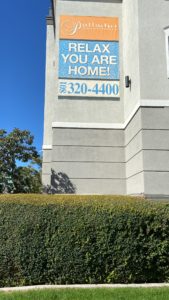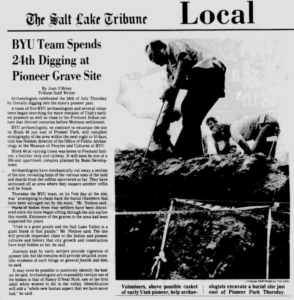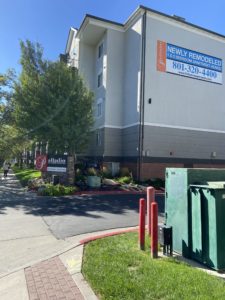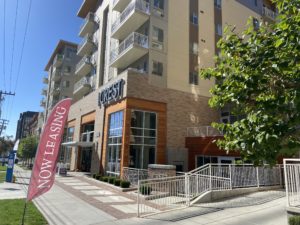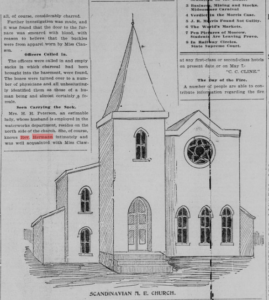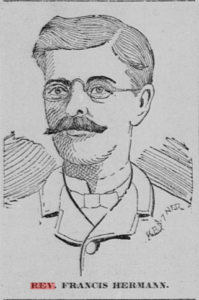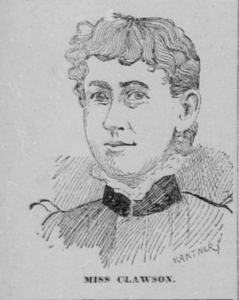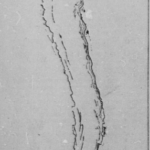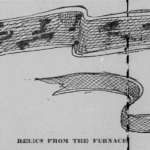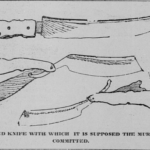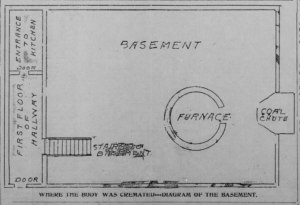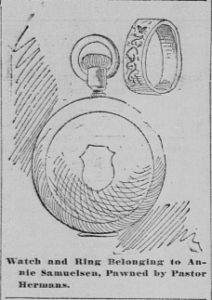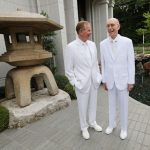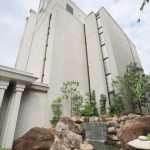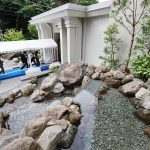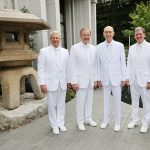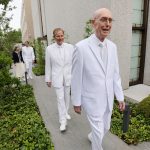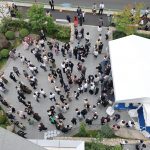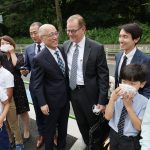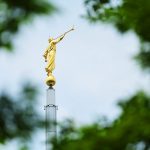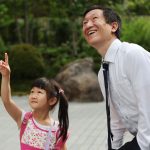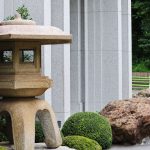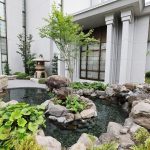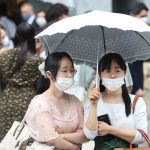In Sept. 1823, Moroni appeared to the Prophet Joseph Smith and the marvelous work and a wonder began.
As we approach the 200th anniversary of that event, what have we learned about the situation of the Smith family, and the Prophet Joseph Smith in particular, in 1823, just preceding Moroni’s appearance?
Many relevant and important details about those foundational events have come to light through the efforts of dedicated historians.
This History of the Saints special presentation shares what we have learned.
History of the Saints: The Doctrine & Covenants
What is the Doctrine and Covenants, how did it come to be, and what is its role in the Lord’s work? This is the timely and important subject of this special presentation of History of the Saints. President Benson said in April 1987 “God bless us all to use all the scriptures, but in particular the instrument He designed to bring us to Chris—the Book of Mormon, the keystone of our religion—along with its companion volume, the capstone, the Doctrine and Covenants, the instrument to bring us to Christ’s kingdom, The Church of Jesus Christ of Latter-day Saints.”
General Conference Documentaries
You can watch all of the General Conference documentaries like this on the KSL-TV app. The app is free with no cable subscription required. And it’s available for a variety of smart TV and smartphone platforms including Amazon Fire, Roku, iOS, Android and fourth-generation Apple TV boxes.
History of the Saints: The Joseph Smith Papers
The Joseph Smith Papers
The Joseph Smith Papers are a wealth and treasure of understanding. It is one of the most significant historical works of our generation. In History of the Saints, church historians talk about how many volumes have been released and more are coming in the years ahead. All of this work serves to affirm the faith of the Saints. Just released is the newest volume in the Documents Series—Documents Volume 9. It is different than previous volumes because of the short span of time it covers and is a wealth of information. If you have had questions about the origins of the Relief Society, or Joseph Smith as a Mason, or of the Prophet’s many and varied roles of leadership in Nauvoo—then this program will be of great help to you.
General Conference Documentaries
You can watch all of the General Conference documentaries like this on the KSL-TV app. The app is free with no cable subscription required. And it’s available for a variety of smart TV and smartphone platforms including Amazon Fire, Roku, iOS, Android and fourth-generation Apple TV boxes.
SALT LAKE CITY – The Church History Museum opened a new interactive exhibition to teach children about temples that will be in place during the renovation of the Salt Lake Temple. Also on Wednesday, Church officials released “Saints” volume 2.
The new book focuses on building temples in the West and addresses several more difficult periods in Latter-day Saint Church history.
“One of the things we’re trying to do with ‘Saints’ is to tell a global history of the Church,” said Matthew Grow, director of publications for The Church of Jesus Christ of Latter-day Saints. Grow oversaw the team of writers for this project.
“Saints” volume 2 covers Latter-day Saint history from 1846 to 1893, discussing the trek West, immigrants who strengthened the faith and Native Americans who helped the Saints. The complete title is “Saints: No Unhallowed Hand.”
Saints, Volume 2: No Unhallowed Hand
Grow said all four volumes have titles from Joseph Smith’s Wentworth Letter, explaining the faith to a journalist in 1843.
“There was a great effort in the second half of the 1800s of the American government (and) other people who opposed the Latter-day Saints and what they were trying to establish in Utah,” Grow said.
As with the first volume, this one focuses on some well-known individuals, such as Brigham Young.
Grow said Young was tough but was also accessible to the Saints.
“They didn’t call him President Young. They called him Brother Brigham, and there’s a great significance in that,” Grow said. “They believed that Brigham was one of them, that he knew them. He took time to understand their concerns, to answer their letters, to sit and counsel with them.”
Readers will also find the story of his daughter, Susa Young Gates. Gates was a suffragist, but struggled with an abusive husband, divorce, and child custody.
Grow said the story of “Saints” includes tragedy and mental illness – everything we experience today. The volume also tells the story of plural marriage.
“It’s one of the most difficult things for us to understand; it’s just so foreign to our own sensibilities,” Grow said. “But one of the things we tried to highlight is that they were engaged in plural marriage because of their faith.”
Grow said of those who practiced polygamy, some succeeded as families, while others did not. Many people also faced challenges and tests of faith when the Manifesto to end polygamy was issued in 1890.
The Mountain Meadows Massacre is also referenced in the volume.
In 1857, a Mormon militia slaughtered more than 120 members of a wagon train from Arkansas in southern Utah. Grow said this was a difficult chapter to write and read.
“When they were pushing their own agendas, when they were trying to save themselves or their own reputations, trying to cover up the bad decisions they’d already made, that’s when it got more and more tragic,” Grow said.
“Saints” volume 2 features the building of temples in the West – St. George, Manti, and Logan, and ends with the iconic structure in Salt Lake.
Grow said the writers did not know about the closing of the Salt Lake Temple for a seismic upgrade, but he believes readers will enjoy the history.
“So, there is this really interesting timing, all the things going on with the temple today and we have the back story in ‘Saints,’” said Grow.
‘Temples Dot The Earth’ Exhibit
Speaking of timing, a new children’s exhibit called “Temples Dot the Earth” debuted at the Church History Museum.
It begins with a painting of a young Jesus leaving the temple in Jerusalem with his parents then moves to a world map where children can identify countries and temple locations.
The brightly painted rooms have toys and activities for younger children, like stacking a spire and topping it with an Angel Moroni. For older children, there are computer games about temples, building Solomon’s temple and what happens in temples versus meetinghouses.
“We felt it was so important to learn through creative play, through activities, through artifacts about the temple and about why we build temples, why we attend temples, and why they’re so central to our faith,” said Maryanne Stewart Andrus, exhibits and education supervisor. Andrus was a team leader on the project, which took two-and-a-half years to complete.
There is history to learn in the exhibit as well, with temple artifacts.
“We’ve got some tools that were used in the design of the Nauvoo Temple,” said curator Alan Morrell. “All of the Utah temples are represented. We have some carpet from the Logan Temple.”
Part of the exhibit looks like a temple interior with an interactive model. Children can pick up a cardboard-backed photograph, each one representing a temple room somewhere in the world, and then slide it into an area of the model to make it 3-D.
Alan and Maryanne said they hope that families will enjoy the exhibit together as well as invite their friends of other faiths.
Both the book’s writers and exhibition curators said they hope each will provide the Saints with greater understanding and faith.
“Saints” volume 2 is now available as a book, online, and as an audiobook in 14 languages. The children’s temple exhibition will be at the Church History Museum for the next four years.
Saints Church History
Church History
Discover stories from Church archives that are seldom heard. The new Saints Church history volumes share a unique perspective on the history of The Church of Jesus Christ of Latter-day Saints. The story-telling style allows for the discovery of how the early church was formed and what the Saints experienced in those early years. This documentary takes you behind the scenes of the creation of these new books. Meet the historians and scholars associated with these works and hear why these history books are written in a more narrative form.
General Conference Documentaries
You can watch all of the General Conference documentaries like this on the KSL-TV app. The app is free with no cable subscription required. And it’s available for a variety of smart TV and smartphone platforms including Amazon Fire, Roku, iOS, Android and fourth-generation Apple TV boxes.
Saints QB Taysom Hill Powers Into End Zone For Touchdown Against Lions
SALT LAKE CITY – Former BYU Cougars quarterback Taysom Hill fought his was across the goal line for a touchdown during the Week 13 NFL game between the New Orleans Saints and Detroit Lions.
Taysom Hill finds paydirt in Week 13
The Saints hosted the Lions at Caesars Superdome in New Orleans, Louisiana on Sunday, December 3.
RELATED: Saints QB Taysom Hill Makes NFL History With Touchdown Catch Against Bears
With 4:34 left in the third quarter, Hill took a direct snap and burst forward into a pile of players before powering his way into the end zone. Hill’s one-yard touchdown run cut Detroit’s lead to 24-21.
.@T_Hill4 finds the end zone for his fourth rushing touchdown of 2023.#LocalsInTheNFL #NFL #DETvsNO #Saints #BYUFOOTBALL @kslsports pic.twitter.com/zqhzaLbaEz
— Kyle Ireland (@kyleireland) December 3, 2023
The score capped a seven-play, 62-yard drive that took 3:37.
Hill entered the game with 57 carries for 287 yards and three touchdowns on the ground this season. The Saints came into the game with a 5-6 record.
New Orleans’ game against Detroit is broadcast on FOX and NFL Sunday Ticket.
About Taysom Hill
Prior to his NFL career, the Idaho native was a quarterback at BYU. Hill played for the Cougars from 2012-16.
During his college career, Hill threw for 6,929 yards, 43 touchdowns, and 31 interceptions. He ran for 2,815 yards and 32 touchdowns.
After going undrafted, Hill signed a free agent deal with the Green Bay Packers. Before the regular season, Hill was waived by the Packers and picked up by the Saints. Since then, Hill has become a key piece of New Orleans’ offense.
.@T_Hill4 x2
The former @BYUfootball quarterback finds paydirt for the second time today.#LocalsInTheNFL #NFL #Saints #NOvsIND #BYUFOOTBALL @kslsports pic.twitter.com/ODdmZJYrS3
— Kyle Ireland (@kyleireland) October 29, 2023
During his NFL career, Hill has played multiple positions, including quarterback, running back, wide receiver, and tight end.
Kyle Ireland is a Sports Producer and Locals in the NFL Insider for KSLSports.com. He’s also co-host of the Yards After College Podcast. Follow him on X/Twitter (@kyleireland), Instagram (@kyleirelandksl), and Threads (@kyleirelandksl).
Instant Replay: Taysom Hill Makes Impressive Catch During Saints’ Week 12 Game
SALT LAKE CITY – Former BYU Cougars quarterback Taysom Hill made an impressive reception during the Week 12 NFL game between the New Orleans Saints and Atlanta Falcons.
Taysom Hill makes great catch in Saints-Falcons game
The Falcons hosted the Saints at Mercedes-Benz Stadium in Atlanta, Georgia on Sunday, November 26.
With 3:50 remaining in the opening quarter, Saints quarterback Derek Carr floated a ball toward the sideline before Hill went up and snatched the ball out of the air for a 36-yard gain to the Falcons’ 19-yard line.
What a catch by, @T_Hill4. #LocalsInTheNFL #NFL #Saints #BYUFOOTBALL @kslsports pic.twitter.com/GEJY82buaq
— Kyle Ireland (@kyleireland) November 26, 2023
The drive ended up resulting in a pick-six for the Falcons.
Atlanta won the contest by a score of 24-15.
Hill finished the contest with seven carries for 26 yards and two catches for 55 yards. Hill entered the Week 12 game having recorded 22 receptions for 159 yards and one touchdown this season. He’d also run the ball 50 times for 261 yards and three touchdowns and thrown for 72 yards and a touchdown this season.
With the loss, the Saints dropped to a 5-6 record this season. New Orleans’ next game is at home against the Detroit Lions on Sunday, December 3 at 11 a.m. (MT) on FOX.
About Taysom Hill
Prior to his NFL career, the Idaho native was a quarterback at BYU. Hill played for the Cougars from 2012-16.
During his college career, Hill threw for 6,929 yards, 43 touchdowns, and 31 interceptions. He ran for 2,815 yards and 32 touchdowns.
After going undrafted, Hill signed a free agent deal with the Green Bay Packers. Before the regular season, Hill was waived by the Packers and picked up by the Saints. Since then, Hill has become a key piece of New Orleans’ offense.
— Kyle Ireland (@kyleireland) November 5, 2023
During his NFL career, Hill has played multiple positions, including quarterback, running back, wide receiver, and tight end.
Hill has scored 47 total touchdowns during his NFL career.
Kyle Ireland is a Sports Producer and Locals in the NFL Insider for KSLSports.com. He’s also co-host of the Yards After College Podcast. Follow him on X/Twitter (@kyleireland), Instagram (@kyleirelandksl), and Threads (@kyleirelandksl).
Saints QB Taysom Hill Has Jersey Put In Pro Football Hall Of Fame
SALT LAKE CITY – After putting his name in the NFL record books two weeks ago, Saints QB Taysom Hill had his jersey set up in the Pro Football Hall of Fame.
Hill isn’t the first player with local ties to receive that honor this season. Colts kicker Matt Gay and Rams wide receiver Puka Nacua also had their jerseys set up in Canton, Ohio this year.
🗣️ New to the Pro Football Hall of Fame
The jersey, wristband & shoes that @T_Hill4 of the @Saints wore in Week 9, when he joined Frank Gifford as the only players in NFL history with at least 25 rushing, 10 passing & 10 receiving TDs.
Full Story: https://t.co/33MKeMtWYu pic.twitter.com/4rfoyMNm5E
— Pro Football Hall of Fame (@ProFootballHOF) November 14, 2023
Against the Chicago Bears in week nine, Hill became the first NFL player to score 10 or more touchdowns in rushing, passing, and receiving since Frank Gifford hit the mark in 1957.
RELATED: Saints QB Taysom Hill Makes NFL History With Touchdown Catch Against Bears
Gifford played for the New York Giants from 1952-60, 1962-64. He finished his career with 14 passing touchdowns, 34 rushing touchdowns, and 43 receiving touchdowns. He hit the mark of 10 touchdowns in all three categories during the 1957 season.
Taysom Hill is the first @NFL player to have at least 10 career:
rushing TDs
passing TDs
receiving TDssince @ProFootballHOF member Frank Gifford! pic.twitter.com/aJxBF4zS6B
— New Orleans Saints (@Saints) November 5, 2023
Hill entered the game with 10 passing touchdowns, 26 rushing touchdowns, and nine passing touchdowns.
Later in the game, Hill connected with Juwan Johnson for his first touchdown pass of the season.
The Saints held off the Bears for a 24-17 win.
.@T_Hill4 continues to tear it up.
Hill hits Juwan Johnson for his first touchdown pass of the season.#LocalsInTheNFL #NFL #Saints #CHIvsNO #BYUFOOTBALL @kslsportspic.twitter.com/7k3qIdStdJ
— Kyle Ireland (@kyleireland) November 5, 2023
About Taysom Hill
Prior to his NFL career, the Idaho native was a quarterback at BYU. Hill played for the Cougars from 2012-16.
During his college career, Hill threw for 6,929 yards, 43 touchdowns, and 31 interceptions. He ran for 2,815 yards and 32 touchdowns.
After going undrafted, Hill signed a free agent deal with the Green Bay Packers. Before the regular season, Hill was waived by the Packers and picked up by the Saints. Since then, Hill has become a key piece of New Orleans’ offense.
Former @BYUfootball QB @T_Hill4 breaks free for a @Saints touchdown, his second rushing score in as many weeks.#LocalsInTheNFL #NFL #Saints #NOvsIND #BYUFOOTBALL @kslsports pic.twitter.com/ws6TWQuQhC
— Kyle Ireland (@kyleireland) October 29, 2023
During his NFL career, Hill has played multiple positions, including quarterback, running back, wide receiver, and tight end.
Hill has scored 44 total touchdowns during his NFL career.
Are you on Threads yet? Let’s connect, give us a follow @kslsports.
Chandler Holt is a co-host for the Jazz Notes podcast and a Digital Sports Producer for KSLSports.com, specializing in all things basketball and football. Follow Chandler on Twitter @ChandlerHoltKSL or on Threads @chandlerho1t.
Take us with you, wherever you go.
Looking Back At History Of BYU-Texas Football Series
PROVO, Utah – One man brought the BYU/Texas football series to life in 1987.
That man was Lou Holtz.
You’re probably thinking, wait, THAT Lou Holtz? Yes, the former Notre Dame headman and your favorite former ESPN analyst, Lou Holtz.
Before Holtz was at Notre Dame, he was the head coach at Minnesota. He took the head post in Minneapolis after a seven-year stint in Arkansas in the winter of 1984.
Holtz’s first line of business as the head coach of the Gophers was to lighten up future schedules. Two of those teams that he wanted to remove from Minnesota’s future schedules were BYU and Texas.
Minnesota had home-and-homes with BYU and Texas for the 1987 and 1988 seasons.
The Longhorns and Cougars suddenly needed games. Texas AD DeLoss Dodds and BYU AD Glen Tuckett came together and brought together a series that no one ever expected to happen.
Since 1987, BYU and Texas have met five times on the football field. This Saturday will be the sixth and likely final meeting these two programs ever have against each other. It will be a memorable one as it will come as two Big 12 foes.
September 12, 1987: BYU 22, Texas 17
Texas Memorial Stadium (Austin, Texas)
The first-ever meeting saw BYU roll into Austin with Bob Jensen at quarterback and escape with a victory over the Longhorns. BYU’s defense produced a big performance, producing a sack in the third quarter. Kicker Leonard Chitty had a pair of field goals and BYU came away with the five-point win.
September 8, 1988: BYU 47, No. 19 Texas 6
Cougar Stadium (Provo, Utah)
BYU rolled through Texas in Provo. The Longhorns star tailback Eric Metcalf was suspended for taking money for a summer school session before the game kicked off. Imagine that sort of suspension in today’s college football.
Anyway, Sean Covey was dealing to the tune of 323 yards as BYU got a signature win over a mediocre Texas squad.
September 10, 2011: Texas 17, BYU 16
Darrell K. Royal-Texas Memorial Stadium (Austin, Texas)
Often forgotten in this game is that BYU had a 13-0 lead in the second quarter. BYU’s offense, which was revamped with Brandon Doman as offensive coordinator, struggled out of the gates with the increase of competition on an Independent schedule.
Texas rolled with Garrett Gilbert at quarterback, then had Case McCoy and David Ash play in the game. Despite having three different QBs, the Longhorns squeaked out their lone victory over BYU.
September 7, 2013: BYU 40, No. 15 Texas 21
LaVell Edwards Stadium (Provo, Utah)
Thunderstorms delayed what would be a monsoon of rushing yards from BYU against a lifeless Texas team. Less than four years after playing for the National Championship, Texas coach Mack Brown unofficially saw his tenure come to an end in Provo.
Taysom Hill rushed for 259 yards and Jamaal Williams popped off another 182 in BYU’s “Go Fast, Go Hard” offense that left Texas defensive coordinator Manny Diaz with a pink slip the following day.
September 6, 2014: BYU 41, Texas 7
Darrell K. Royal-Texas Memorial Stadium (Austin, Texas)
BYU is well aware of big-name opponents downplaying their effort level against the Cougars after losses. Did they want to be there? That sort of thing.
There was no question Texas wanted to get revenge for what happened against BYU the year before. The September 2014 issue of Texas Monthly featured new Texas head coach Charlie Strong with Texas AD Steve Patterson. On the cover, the headline read, “Can a new athletics director and a new attitude return UT to glory? (Or at least beat BYU?)”
Taysom Hill had other plans.
The hurdle from Hill is one of the iconic moments in BYU football’s history.
Hill rushed for 134 and passed for 181, accounting for three touchdowns as BYU steamrolled Texas again.
October 28, 2023: BYU at No. 7 Texas
Darrell K. Royal-Texas Memorial Stadium (Austin, Texas)
Win or lose on Saturday for BYU, the Cougars should thank the Longhorns before they leave Austin. Without Texas getting antsy and wanting to leave for the SEC, BYU isn’t in the Big 12.
That’s the ultimate victory for BYU.
But one last time in Austin as conference foes should make for an entertaining stage.
Date: Saturday, October 28, 2023
Location: Darrell K. Royal-Texas Memorial Stadium
Kickoff: 1:30 p.m. (MT)
TV: ABC
Radio: KSL NewsRadio (102.7 FM, 1160 AM) — Extended pregame coverage begins at 9 a.m.
Mitch Harper is a BYU Insider for KSLsports.com and host of the Cougar Tracks Podcast (SUBSCRIBE) and Cougar Sports Saturday (Saturday from 12–3 p.m.) on KSL Newsradio. Follow Mitch’s coverage of BYU in the Big 12 Conference on X and Threads: @Mitch_Harper.
Take us with you wherever you go.
Trevor Lawrence Comes Through Late, Jaguars Hold Off Saints
NEW ORLEANS (AP) — Jacksonville quarterback Trevor Lawrence was playing with a sprained left knee, and the visiting Jaguars hurt their own cause with turnovers and penalties.
Jaguars beat Saints in Week 7
They were still good enough to overcome that and pull out a dramatic victory that extended their winning streak to four games.
Travis Etienne ran for two touchdowns, Foyesade Oluokun returned an interception for a score, and Christian Kirk’s late 44-yard touchdown after a short catch over the middle lifted the Jaguars to a 31-24 victory over the New Orleans Saints on Thursday night.
“I don’t think I’ve run that fast since college,” said Kirk, a former Texas A&M star, whose late score made up for his lost fumble in the first half. “That was some vintage stuff. I’m glad I was able to do it in that moment.”
Lawrence returned from the knee injury that forced him out of the final minutes of a victory over Indianapolis on Sunday and wound up leading Jacksonville (5-2) with 59 yards rushing.
“It’s crazy how you have something like that going on and don’t plan on moving a lot, and you end up running the ball more than you usually do,” Lawrence said. “It felt pretty good. It didn’t bother me too much and definitely didn’t set it back. That was the goal, to play, find a way to win the game and not set it back.”
The @Jaguars get a big win in The Big Easy. #TNFonPrime pic.twitter.com/QOgV1UirYX
— NFL on Prime Video (@NFLonPrime) October 20, 2023
Lawrence also completed 20 of 29 passes for 204 yards and one TD to help the Jags secure their best start since opening 5-2 in 2007.
After Kirk’s touchdown broke a 24-all tie with 3:08 left, the Saints (3-4) were in position to answer when they drove inside the Jacksonville 10 in the final minute, but stalled out with four straight incomplete passes.
Derek Carr’s third-down pass bounced off of tight end Foster Moreau’s hands in the back of the end zone and a fourth-down timing throw to Chris Olave along the left sideline fell incomplete.
The 4th down pass is incomplete and the @Jaguars are going to get the victory#JAXvsNO on Prime Video
Also available on #NFLPlus https://t.co/89nUeCngbn pic.twitter.com/s818wxCpyC— NFL (@NFL) October 20, 2023
“We’re finding it hard to start fast, finding it hard to maintain, to execute sometimes and we’re finding it hard to finish,” said Saints running back Alvin Kamara, who gained 153 yards from scrimmage on a mix of runs and catches. “That’s kind of the glaring and recurring theme.”
As time ran out, Moreau, a New Orleans native in his first season back home, looked disconsolate on the bench with his head in his hands. Teammates consoled him and later said there were too many other missed opportunities throughout the game to pin the loss on his drop.
“It doesn’t come down to one play,” Carr said. “There’s so many things that we could have done.”
Jacksonville gave the Saints numerous chances to stay in the game, losing two fumbles in the first half and committing untimely penalties throughout the game.
It almost came back to haunt them.
The Saints rallied from 24-9 down to tie the game on touchdowns by Taysom Hill on a 1-yard, fourth-down run and Michael Thomas on a 17-yard reception — the latter followed by Carr’s pass to Kamara for a 2-point conversion.
RELATED: Taysom Hill Scores First Touchdown Of Season On Thursday Night Football
.@T_Hill4 runs it in for his first touchdown of the season.#LocalsInTheNFL #NFL #Saints #JAXvsNO #BYUFOOTBALL @kslsports pic.twitter.com/SLO0eIBDFM
— Kyle Ireland (@kyleireland) October 20, 2023
Carr finished 33 of 55 for 301 yards, and New Orleans outgained Jacksonville 407 yards to 330, but the Saints again struggled to finish promising drives in the end zone after losing in a similar fashion in Week 6 at Houston.
After practicing on a limited basis this week and being listed as questionable, Lawrence completed five of his first six passes for 60 yards and even scrambled for 9 yards during a game-opening touchdown drive that ended with Etienne’s 2-yard run.
“We have to do a better job of not letting the freakin’ quarterback scramble,” Saints coach Dennis Allen said, calling Lawrence’s improvised runs a “black eye on the whole thing.”
New Orleans’ first drive ended wit Blake Grupe’s missed 51-yard field goal. But the Saints got the ball right back when Kirk was stripped by cornerback Paulson Adebo after a 19-yard catch and defensive end Carl Granderson recovered.
When New Orleans punted soon after, Jacksonville turned it over again when Tevaughn Campbell, who was trying to block, collided hard with returner Jamal Agnew as Lou Hedley’s punt descended and hit Campbell’s back.
Lonnie Johnson recovered for New Orleans, which stalled on the Jaguars 5 and settled for Grupe’s field goal.
Etienne became the first player in Jaguars history to rush for two touchdowns in three consecutive games when he ran around the left end for a 17-yard score that made it 14-3.
🅿️rimetime#JAXvsNO | #DUUUVAL pic.twitter.com/XSalWMNUYI
— Jacksonville Jaguars (@Jaguars) October 20, 2023
After their seventh third-down failure of the first half, the Saints settled for another Grupe field goal.
In the final minutes of the half, Jacksonville converted a fake punt with punter Logan Cooke completing a 13-yard pass to Tim Jones on fourth and 2, setting up Brandon McManus’ 43-yard field goal for a 17-6 halftime lead.
INJURIES
Jaguars: Safety Andre Cisco received attention on the field late in the third quarter but was able to walk off on his own.
Saints: Carr appeared to finish the game in pain, but it was not immediately clear what was ailing him. … Alontae Taylor left the game briefly in the first quarter with an apparent cut on his nose and returned for the next series.
The 5-2 Jacksonville @Jaguars pic.twitter.com/X33j8iWHB4
— NFL (@NFL) October 20, 2023
UP NEXT
Jaguars: Travel to Pittsburgh on Oct. 29.
Saints: Visit Indianapolis on Oct. 29.
Celebrate Black History Month in Utah at these events
SALT LAKE CITY — Black history in the Beehive State dates back even longer than Latter-day Saint history in the area, predating the Saints’ arrival by almost 25 years.
In fact, African Americans like James P. Beckworth and Jacob Dodson were a part of fur trapping and exploratory expeditions in the Utah territory. And three Black slaves — Green Flake, Oscar Crosby and Hark Lay — were among the group that arrived in Utah with Brigham Young in 1847. Issac James, Jane Manning and their sons arrived later that year; they were the first free Black pioneers to settle in the state. By 1850, the census listed 24 “free persons of color” and 26 Black slaves in Utah.
Since those early days of settlement, Utah has had a small but vibrant Black community whose contributions have included farming and settling the Millcreek area, serving in the military at Fort Douglas and Fort Duchesne — including the country’s first Black general, Benjamin O. Davis Sr. — expanding railroads and mines in the state and establishing numerous businesses, churches and social groups like the Salt Lake and Ogden branches of the NAACP.
Today, over 50,000 Black Utahns live in the state, making up 1.5% of the population. Despite its small numbers, Utah’s Black community continues to make a large impact on the state.
Below are a number of events and resources to honor the triumphs and challenges of Black Utahns during Black History Month and beyond.
Poetic justice open mic
The Black Cultural Center, UBLAC (Utah Black Artist Collective) and the Union Programming Council are hosting an open mic night Thursday at 6 p.m. at Union Theatre in Salt Lake City. The public is invited to share their singing, poetry, comedy and other talents.
Beloved Community Project film and panel
The film “Beloved Community Project” focuses on Dr. Martin Luther King Jr.’s vision of a “beloved community” in which everyone is cared for and there is an absence of poverty, hunger and hate. The panel will discuss where America is today and will include a reenactment of a 1963 discussion between civil rights leaders about the challenges African Americans faced.
The film and panel are from 2-4 p.m. on Feb. 13, followed by a reception at the Salt Lake Community College Redwood Campus in the Technology Building Auditorium. Reserve a free ticket here.
An evening in Harlem
The Utah Black Chamber is hosting its annual gala celebrating the Harlem Renaissance — the intellectual and cultural movement within the Black community during the 1920s and ’30s. The gala is Feb. 3, 7-10 p.m. at the Ken Garff Scholarship Club in Salt Lake City. Attendees should come dressed in their best 1920s attire for an evening of food, socializing, music, dancing and casino games. Tickets are available here, and the proceeds benefit the Black Success Center.
Civil rights songs and spirituals concert
Salt Lake Community College Chamber Singers will be joined by award-winning baritone Robert Sims for a concert from 7:30-9 p.m. on Feb. 15 at the college’s South City Campus. The evening will include African American spirituals, civil rights songs and other inspiring music. Reserve a free ticket here.
Black, Bold & Brilliant film series
The Utah Film Center’s Black, Bold & Brilliant series focuses on authentic and nuanced representation through film critique and discussions led by Black Utahns. This month the center will offer showings of “Little Satchmo,” which explores the life and legacy of Louis Armstrong through his relationship with the daughter the public never knew existed. Showings are Feb. 15 at 7 p.m. and Feb. 16 at 11 a.m. The public can reserve tickets for free here.
Sip and learn about Black History
The Cocktail Collective is hosting an event focused on cocktails created by America’s Black bartenders. The event will include a hands-on cocktail lesson, take-home recipes, a light snack and a brief historical deep dive into the cocktails and their creator. Registration is available here.
Utah: Black and open for business
The Utah Black Chamber and its partners are hosting a hospitality suite and art exhibit at the Zions Bank Eagle Emporium Building in Salt Lake, Feb. 16-17 from 10 a.m. to 2 p.m. NBA All-Star Weekend attendees are encouraged to network with Utah’s Black business community and enjoy an exhibit featuring work from New York native and Utah resident Diann Harris-Wright. The event will also offer warm drinks and other programs through the chamber’s partners.
Mardi Gras in the Mountains Ball
On Feb. 18, the Leonardo Museum will transform into a Mardi Gras ball fit for New Orleans. The event will span all three floors of the museum and will include a crowning of the queen, regalia, live music and food from local Black eateries. The event is a signature event of the Utah Black Chamber. Tickets are available here.
Afro-Mexican photo exhibit
The Mexican Consulate in Salt Lake City is hosting a photo exhibit titled “Beyond the Signs” by photographer Maricela Figueroa Zamilpa, who has been documenting daily life portraits showcasing Mexico’s cultural diversity since the ’90s. The exhibit is dedicated to the Afro-Mexican peoples of the Mexican states Guerrero and Oaxaca. The exhibit is available in English and Spanish and is open during the month of February.
BYU ‘Perspectives’ show
Brigham Young University is hosting “Perspectives,” a show that “celebrates and portrays the richness and diversity that exists among and within various Black cultures in different forms such as music, dance, fashion, gospel music, poetry and life experiences with the BYU community.” The free show is Feb. 17 at 7 p.m. in the Wilkinson Student Center Ballroom on BYU’s Campus. It will also be livestreamed on BYU’s website.
WSU Black History Month speaker
Weber State University is hosting civil rights activist Fred Hampton Jr. for a free keynote address on Feb. 8, 12:30-2 p.m. at the Shepherd Union Ballrooms on campus. Hampton is the son of Black Panther Party leader Fred Hampton, who was assassinated during the civil rights movement. Hampton Jr. is also the president and chairman of the Prisoners of Conscience Committee and the Black Panther Party Cubs.
‘One Night in Miami…’ movie night
The Black Cultural Center at the University of Utah is hosting a movie night and discussion of “One Night in Miami…” on Feb. 22, 6-8 p.m. The R-rated film explores the friendship between Muhammad Ali, Malcolm X, Sam Cook and Jim Brown. Register to attend here.
Learn more about Black history in Utah
There are a number of resources about Black history in the Beehive state, such as:
- The Utah Department of Cultural and Community Engagement’s page on Utah’s African American communities
- The Utah History Encyclopedia entry on African Americans in Utah
- “African Americans and Salt Lake’s west side,” by Utah Department of Cultural & Community Engagement
- “The Utah Territory Slave Code,” by Black Past
- “The Great White Palace: African American Segregation in Utah,” by Utah Humanities
- “Utah Minorities: The Story Told by 150 Years of Census Data”
- “Black Utah: Stories from a Thriving Community” by the Utah Black Chamber
Three Salt Lake places that should be haunted based on their spooky history
SALT LAKE CITY — Forgotten graveyards, a reverend serial killer, and a Halloween mask in a lake — here are three places in Salt Lake that have particularly spooky histories. Two apartments and a local park have chilling pasts that may continue to haunt the premises.
You decide.
Rachel Quist, an archaeologist, and Fiona Robinson Hill, a historian, talked with me about some unique and lesser-known spooky histories.
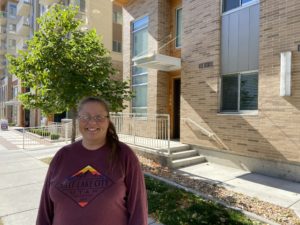
Rachel Quist, an archaeologist, shown in front of the Liberty Crest Apartments in Salt Lake City, the former location of the Scandinavian Methodist Episcopal Church.
Quist studies the history of Salt Lake extensively and has an Instagram and blog where she shares her latest findings. Robinson Hill works as a historian and enjoys leading Grimm Ghost Tours around Salt Lake City.
Liberty Park
A murder has haunted the lake at Liberty Park since 1920. The mystery surrounding 40-year-old Frances “Frae” Korous, who was believed to be murdered and then dumped in the lake, has never been solved.
A few days after Halloween, 13-year-old Truman Pratt was sailing his toy boat at the southern end of Liberty Park Lake when he saw what he believed to be a Halloween mask floating in the water about 15 feet from the shore.
Pratt fashioned a wire on a stick, and used it to pull the mask towards the shore, but once pulled closer, he realized it was attached to the body of a woman.
The Salt Lake Telegram published an interview in 1920 with Pratt who stated:
“The hook caught in what I thought was a mask, and I started to pull it ashore. It was unusually heavy, I thought, for a mask, so I was careful not to break my hold on it. When I got the object close to the shore and saw it was a body I gave a scream…”
Horrified, he ran to tell Park Superintendent, Sidney R. Lambourne, who contacted Salt Lake City Police.
The body was identified as, “Miss Frances Korous,” and was found with a white cloth tied tightly around her neck.
A native of Iowa, Korous had worked as a nurse in WWI and moved to Salt Lake City after she was discharged from the US Navy, joining her brother, Yaro, and her sister Rose. She lived at the city’s YWCA at 306 E. 300 South until she found a more permanent apartment.
The last time she was seen was the night of Sunday, Oct. 17, 1920.
That evening she attended the Methodist church and then went to visit her brother Yaro and his family for Sunday dinner. At the end of the evening, her brother escorted her to a streetcar to take back to the YWCA for the night.
Korous never made it back to YWCA and was never heard from again.
As relatives became concerned, search parties, organized by police, were organized to find her and Boy Scouts even searched in nearby canyons for the missing nurse.
Her body was recovered on Nov. 6, 1920, in Liberty Park.
When her body was found, it was discovered in the same clothing she was wearing when she disappeared with all her jewelry intact, and a watch that had stopped at 2:34.
The family of Korous denied any possibility of suicide and the coroner determined that her lungs were not full of water, and neither was her stomach, ruling that she had been killed before she was dumped in the lake.
Previously it had been believed that maybe she had been hit by a car and dragged away, but the tightly knotted rag around her neck and suspicious location of her body pointed to murder.
“The park keeper said that he had been all around the lake several times during the past few weeks. The police say that a body usually rises to the surface within at least ten days after it has entered the water.” However, Korous’ body didn’t rise to the surface until it was found by Pratt, three weeks after her disappearance.
Korous’ murder was never solved, though the lake she was found in (now more of a pond,) still exists in Liberty Park. To our knowledge, no Halloween masks have been recently spotted in the water.
The Palladio Apartments
The Palladio Apartments were built on a former cemetery for Mormon pioneers and an indigenous burial ground. It is likely, because of the rush to finish excavation and continue construction on the apartment buildings, that some remains continue to lie beneath the apartment building. And if you’re thinking, ‘isn’t that the whole premise of the movie “Poltergeist”?’ You would be right.
The remains were discovered when construction was beginning on a set of apartments that were built before the currently standing Palladio Apartments.
Construction workers were pouring the foundation for a building and found the remains, but the project was never finished as the company declared bankruptcy, the foundation was then reconfigured for the Palladio Apartments.
“I think at the time there was an idea that there was a cemetery somewhere in the area because you know you have the story of the first child dying, and that’s well before the city cemetery’s established,” Quist said.
She said there was an official archaeology report written about what they found and how they found it; newspapers at the time also covered the discovery.
However, less mentioned at the time was the presence of human remains and artifacts from Native American burials too.
“While they were digging their Mormon burials, they probably, absolutely came into contact with all sorts of artifacts. That’s the case out in Grantsville, that’s the case at Brigham City, Willard, basically everywhere that the Mormons settled they were already settling on a village site,” Quist said.
Construction was halted when formal grave sites were found. Typically, when a body is found during construction, everything is stopped and local authorities are contacted.
“The process now is you contact local law enforcement, generally the police, they then evaluate which path it goes down.”
If the remains are more recent, police begin an investigation into the identity and cause of death. If the remains are historic, archaeologists are called to look into it.
“They’ve encountered human remains with their back hoes there in the back dirt, they’ve already found the Native American remains and either didn’t notice, or didn’t care,” Quist said. “But once they found Mormon Pioneer graves in wood coffins all of a sudden, ‘We’ve got something here, we’ve got to call the authorities.’ ”
Quist explained the pioneer grave sites were obvious with coffins all facing the same direction.
“This was an established, laid out, pioneer cemetery. So everybody’s buried in roughly the same direction, in very rough lines or rows, in [coffins of] milled lumber with wood and metal hardware. So you know for sure, it’s definitely going to be the Mormon pioneer era, because pre-historic burials are different.”
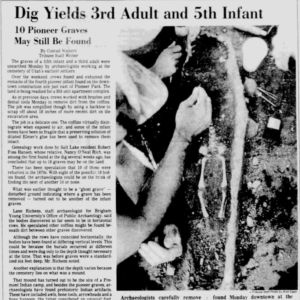
The Salt Lake Tribune reports on new remains discovered in the pioneer cemetery. (Utah Digital Newspapers)
Since the graves were identified as Mormon pioneers, they were given to the Church of Jesus Christ of Latter-day Saints, who arranged to have all the pioneer remains removed and reburied at This is the Place State Park.
According to the This is the Place website:
“The building project paused for quite some time while archaeologists from Brigham Young University’s Public Office of Archaeology undertook an excavation of the cemetery. The remains of those buried were sent to the University of Wyoming for testing and research, and upon their return the bones of 32 bodies were laid in separate coffins. The remains were relocated to This Is the Place Heritage Park on Memorial Day, 1987.
“Research indicates that the very first pioneers who died in the valley were buried in the cemetery unearthed by the construction crew.”
The indigenous remains pre-date the pioneer remains by almost 1,000 years. Three bodies of Native Americans were found, prepared for burials, and two pit houses were discovered dating back to the ancient Fremont Indians.
“The Piute and Goshute are hunter-gatherers, mobile groups,” Quist said. “The Ute were early adopters of the horse so they are all over the place. But [this is] before that time period, so we’re talking roughly, about 2,000 years ago, it’s called the Fremont Era. There was an established village settlement in Salt Lake.”
The indigenous remains were given back to tribes.
“Native American remains take a different path and in this case they were repatriated to a local tribe. I don’t know which tribe though because that was not in the report,” Quist said. “That’s the correct and legal thing to do. They’re repatriated to the tribe, sometimes it’s a group of tribes and they collectively determine amongst themselves what will then happen. And we are not privy to that information.”
The return of indigenous remains is done in a formal process with respect with as much publicity or as little publicity as the tribes desire. In this case, little information is known about what happened to the indigenous remains other than three bodies found were returned to the tribes.
So you might be thinking, “OK bodies were found there, but then relocated, what’s the big deal?”
Well here’s where it gets “Poltergeist” movie-style creepy. Archaeologists had very limited time to complete the excavation.
“They had three weeks to do the excavation which is not very long especially when they’re dealing with human remains, especially child human remains,” Quist said.
I asked Quist what the chances were of remains being left behind.
“Oh I think very high. The archaeologists at the end of their allotted two, three weeks of excavation were pretty adamant that they thought there were other indigenous remains present,” Quist said.
Despite those concerns, construction continued anyway.
Robinson Hill said although there is a small plaque in the corner of block, tenants may have no idea what they’re living on top of.
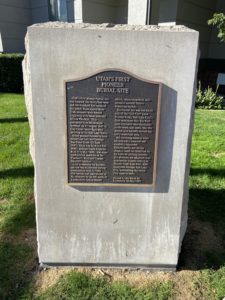
A plaque mentioning the pioneer cemetery and Native American burial ground on the corner of 300 South and 200 West. (Eliza Pace, KSL TV)
“We’re still finding artifacts in this area, so there’s probably remains still around here,” Robinson Hill said. “A lot of times, they do not disclose that information when it comes to indigenous burial grounds in urban settings or even cemeteries like in “Poltergeist,” they don’t disclose that information. People don’t know, ‘hey this used to be an old cemetery.’ ”
As we stood on the block, Quist showed me where these unmarked graves were based on the archaeology report. Meanwhile people walked in and out of the apartment building, some with their morning coffee, some with their pets headed out for a walk, with no idea what had been, and potentially still remained, beneath the surface.
Liberty Crest Apartments
The Liberty Crest Apartments, built on what was formerly a Scandinavian Methodist Episcopal church, was also the home of one of Salt Lake’s first serial killers, Reverend Frances Hermann.
The church sat at 158 S. 200 East in Salt Lake City, the location of Liberty Crest Apartments now.
Hermann who was a well-known pastor in Scandinavian social circles lived in several other states before moving to Salt Lake City in 1895.
“So the Reverend lived in the church, there was kind of a housing unit associated with it, but also a Mr. John M. Hanson, he resided in the second story apartment in the church and he was on the board of trustees,” Quist said. “He was always pretty suspect of the reverend.”
Hermann was known to be close to a 25-year-old Swedish immigrant named, Henrietta Clausen also spelled Clawson by some sources.
“The last time Miss Clausen was seen alive was in the company of the Reverend,” Quist said. “Hansen, the trustee and his wife – they were suspicious since their good friend, Miss Henrietta Clausen, who was a young Swedish immigrant had gone missing.”
Clausen was last seen Sept. 29, 1895 and then disappeared.“She was well known to have been madly in love with him and had been sleeping in his study,” Quist said. “Now the reverend of course denied any improper behavior.”
Apparently Clausen had confided in a friend that he’d proposed marriage to her, that she was pregnant and she had been sleeping in his quarters in the church.
“He certainly had pursued her…” Quist said. “Although I think the cover story was she was his housekeeper.”
When asked about her disappearance, the Hermann said she had “propositioned him” and he in turn rebuked her.
“He said because of his rebuff of her, she must have left the state, and that’s why nobody had seen her,” Quist said.
On Sept. 30, 1895, Hermann had the janitor of the church, only identified as “Johnson,” clean out the furnace in the basement of the church for a fire. The furnace had previously been used to warm the church, but because of a fire that nearly destroyed the building years before, was no longer used.
John M. Hanson who resided in the second story of the church observed that soon after that, Hermann lit a large fire in the furnace accompanied by a terrible stench.
It wasn’t until months later, sometime around May 1896, that Hanson investigated the basement of the church. Hanson found a knife blade, a garter buckle, corset steel, a belt buckle, two straight razors, and several human bones in the Church’s ash grate.
After the human remains were discovered, police became involved and made an even more harrowing discovery: the decomposing torso of Clausen buried in a corner of the church’s dirt floor basement.
Items also recovered by police included bloody overalls of the Reverend found in a bloody barrel, and two false teeth from Clausen.
“They didn’t have real dental records way back then, but they did have a dentist here in Salt Lake who remembered putting in, or working on her mouth and installing those teeth for her,” Quist said. “That’s how they identified the body as being Miss Clausen.”
The door of the furnace was smeared with blood and at 10 inches by 6 inches, was a small opening to fit a body into.
“The police believed that the barrel was used as a butcher block to dismember the body so that at least parts of it would fit into the furnace.”
Police searched two trunks in Hermann’s study and found items belonging to Clausen and another missing Swedish immigrant, Annie Samuelson.
“So now they’ve got two victims,” Quist said. “The police also found bottles of poison, chloroform, which is what I suspect he used, and other drugs, some of which produced abortions and they were found in reverend’s study.”
“Now Miss Samuelson had an aunt living here locally and the aunt admitted to her niece having ‘improper relations,’ ” Quist said. “Her aunt said that the reverend had performed an abortion shortly before her disappearance.”
At that point it was 30 to 40 years in prison if a doctor was caught for providing an abortion, and anyone considered an accomplice to an abortion also could serve jail time.
“According to members of the church, Miss Clausen, after she had gone missing, that’s when Annie Samuelson became the reverend’s favorite. She went missing in January.”
Soon after she went missing Hermann pawned her gold watch and ring.
“So police suspected that Annie Samuelson had also been poisoned by the reverend, her body dismembered, and either burned or buried elsewhere because he was also known to take midnight rides in his carriage out into the country,” Quist said.
The city was shocked and the story was widely circulated, first in Salt Lake and then reaching headlines in papers in San Francisco and Arizona. The Salt Lake Herald reported the story with the headline, “Sanctuary of God defiled with blood” on May 23, 1896.
“Since then the Salt Lake readers were just enthralled and followed this for like the next several months” Quist said.
“It was also found that the reverend embezzled $7,000 of church funds so that’s around $300,000 today, a lot of money,” Quist said.
Here’s where it gets really interesting or just really creepy.
“He [Hermann] had been married three times before and in each instance his wife died under mysterious circumstances and two of his three children also died in unusual circumstances,” Quist said.
Quist and Robinson Hill say there are likely multiple other victims.
“The pattern with serial killers is one, two, if there’s two then there’s a likelihood of more. You don’t just start with one, and you don’t just start with two because then they’re like, ‘I know how to do this,’ ” Robinson Hill said.
Hermann never returned to Salt Lake City and was never charged for his crimes.
The church fell into disrepair and was eventually torn down in 1906, mostly due to the memory of the heinous crimes committed on the premises. The Liberty Crest Apartments remain — standing over the ground where a dismembered and decomposing torso was once found.
The residence of a vicious serial killer who was never apprehended, is now home to hundreds of people.
SALT LAKE CITY — Tens of thousands gathered in downtown Salt Lake City Saturday for the 192nd Semi-annual General Conference of The Church of Jesus Christ of Latter-day Saints.
Each of the three sessions Saturday had a different choir: the Tabernacle Choir at Temple Square in the morning, a choir of missionaries sang in the afternoon, and the evening’s music was provided by a children and youth choir from South Jordan.
The evening session, previously alternating between a priesthood session for men and boys and a women’s session for women and girls, was for all members to attend.
The Saturday evening session in April 2022 was for women and girls, while the evening session in October 2021 was for all members.
History was made in the morning session as Sister Tracy Y. Browning became the first Black woman to speak in General Conference of The Church of Jesus Christ of Latter-day Saints.
Her message encouraged Latter-day Saints to improve their spiritual vision.
“When we fix our sight on Jesus Christ, we recognize, and we understand that he is the only source and way to receive forgiveness and redemption, even unto eternal life and exaltation,” Sister Browning said.
Sister Tracy Y. Browning becomes first Black woman to give conference talk
In April, Sister Browning was sustained as the second counselor in the Primary general presidency. She is the first Black woman to serve in a general presidency.
Within the same session, a redesigned youth standards book was announced.
The new “For the Strength of Youth” booklet is already available online in 50 languages, and printed copies were being handed out Saturday.
Saturday morning, President Russell M. Nelson sat on a raised chair to deliver his five-minute address.
Afterward, on social media, the 98-year-old discussed his age, saying he doesn’t feel old but that a small adjustment, like using a chair, is helpful to those who “age on stage.”
President Nelson’s social media post ended by saying that while he may not ski black diamond runs anymore, he’s delighted to speak, whether standing or sitting.
What a marvelous first session of general conference we have had! I felt spiritually renewed as I listened to those who spoke. They were absolutely inspiring, and I am certain the next four sessions will be equally wonderful. pic.twitter.com/Nq6m2B24AS
— Russell M. Nelson (@NelsonRussellM) October 1, 2022
During his address, President Nelson strongly denounced the abuse of any kind after a series of Associated Press articles questioning the church’s response to child sexual abuse was released.
He said abuse is a grievous sin and that, as President of the Church, he affirms the teachings of Jesus Christ on the issue.
“Let me be perfectly clear: any kind of abuse of women, children, or anyone is an abomination to the lord. He grieves, and I grieve whenever anyone is harmed. He mourns, and we all mourn, for each person who has fallen victim to abuse of any kind,” President Nelson said.
He grieves and I grieve whenever anyone is harmed. He mourns, and we all mourn, for each person who has fallen victim to abuse of any kind. Those who perpetrate these hideous acts are not only accountable to the laws of man, but will also face the wrath of God.
— Russell M. Nelson (@NelsonRussellM) October 1, 2022
He went on to say that those who commit abuse are accountable to man’s laws and God’s wrath.
President Nelson said that for decades the church has taken extensive measures to protect children from abuse and urged people to be alert to anyone in danger and to act quickly to protect them.
Couple serving mission in London witnesses history as nation mourns their Queen
LONDON — Among the large crowd at Buckingham Palace Friday was a couple serving a mission for The Church of Jesus Christ of Latter-day Saints.
Steve Bush, who is from Provo, and his wife, Carol, started their mission in May, serving as senior missionaries for the Britannia Single’s Ward in London.
They said after getting to know the joyful people for the last four months, it is evident those they serve are now in mourning.
“They are sad. They really love their Queen,” Carol said. “For most people, this is the only monarch they’ve known their entire life.”
“We had institute last night and they prayed for the royal family and for what they’re going through.”
Tonight at 10:00, a couple serving an LDS mission in London shares how the Queen’s passing is impacting the people they serve @KSL5TV
**Spot #KingCharles in the second pic pic.twitter.com/Qs21nZSgD3
— Ashley Moser (@AshleyMoser) September 10, 2022
The couple said the mood in the country after news of Her Majesty’s passing broke is unlike anything they have experienced.
Carol had previously been in the United Kingdom for two royal weddings, two royal births, and all three of the Queen’s Jubilees.
She witnessed citizens during those celebratory events and now is observing them during a time of sorrow.
“We had institute last night, and they prayed for the Royal Family and for what they’re going through,” she said.
They witnessed the streets of London transform overnight, with every corner of the city decorated with tributes to Queen Elizabeth II.
“The English do pomp and circumstance better than anyone. It is just truly amazing what they do with the amount of flags and banners and places that they publish,” Steve said.
They said certain buildings where the Queen would shop, like department store Fortnum & Mason in Piccadilly Circus, are also paying tribute in a unique way.
“They blackened all their windows and said in honor of the Queen, we will not have a billboard until after her funeral,” Carol said.
On Friday, the couple witnessed history first-hand as King Charles III greeted the crowds outside Buckingham Palace.
“It was amazing! It was a time of great patriotism. Everybody was rallying around, excited that this is a time for the country to come together,” Steve said.
To witness the transition of a nation and to celebrate Her Majesty’s life and legacy is something they will never forget.
“To be here, to actually be with the people of London to celebrate her, we are happy,” Carol said.
They said the city had also postponed planned events and instead put into action their 10-day funeral plan dubbed Operation London Bridge.
King Charles III will officially be pronounced in a ceremony Saturday, with the coronation at a later date, yet to be announced.
TOKYO — The Church of Jesus Christ of Latter-day Saints has rededicated its longest operating temple in Asia.
President Henry B. Eyring, second counselor in The First Presidency of The Church of Jesus Christ of Latter-day Saints, presided over the rededication in Tokyo, Japan, on Sunday.
“This is a great thing for this nation. It is a great thing in the world to have a temple of God. I feel grateful just to be here,” President Eyring said.
The temple was originally dedicated on Oct. 27, 1980, as the 18th temple of the Church.
However, it closed in September 2017 to undergo renovations to its interior and exterior.
A visitor center, chapel, area and missions offices, and a family history center were added to the historic temple, according to the release.
President Eyring was joined by several Church members like Elder Gary E. Stevenson of the Quorum of the Twelve Apostles.
Both President Eyring and Elder Stevenson have ties to Japan.
“When I come here, I feel like I’m coming home,” President Eyring said.
Elder Stevenson served as a missionary in Japan from 2004 to 2007. He says the country is a part of his “spiritual DNA.”
“We had 19,000 people come to the temple open house,” Elder Stevenson said. “Including many influential people in Japan from government, commerce, education, and religion.”
The refurbished Tokyo Japan Temple is 53,779 square feet with Japanese landscaping and interior esthetics.
The release states that Japan is home to over 130,000 Latter-day Saints.
History lessons: Are Utahns ‘waking up’ to the Great Salt Lake’s peril?
This article is published through the Great Salt Lake Collaborative, a solutions journalism initiative that partners news, education and media organizations to help inform people about the plight of the Great Salt Lake — and what can be done to make a difference before it is too late. Read all of our stories at greatsaltlakenews.org.
SALT LAKE CITY — The Great Salt Lake, already vulnerable to climate fluctuations over the ages, has been “set up to fail” by human impacts, but some of those who are making such assessments nevertheless see hopeful signs in the state’s new enthusiasm to save the vital inland sea.
The lake is known as a terminal lake, meaning it has no outlet and therefore is exposed to major climate-driven changes. In the 1980s, the lake rose 4 meters, causing flooding and even prodding the state to build giant pumps to send the extra water into Utah’s west desert. But now, amid a Western megadrought, the lake is dipping to historic lows, made more significant by upstream diversions and consumption.
“It is normal for a terminal lake to fluctuate, but that makes it easy to excuse what is happening,” said Bonnie Baxter, a Westminster College biology professor who has studied the lake’s biological characteristics and the growing population’s impacts. “Now there really are stark differences and indicators that humans are having an impact on what would be a normal fluctuation.”
However, the deepening lake emergency moved the Utah Legislature this year to create a $40 million program to look at ways to preserve and restore the lake. Baxter, who heads Westminster’s Great Salt Lake Institute, said she sees signs of a groundswell of support for saving the lake.
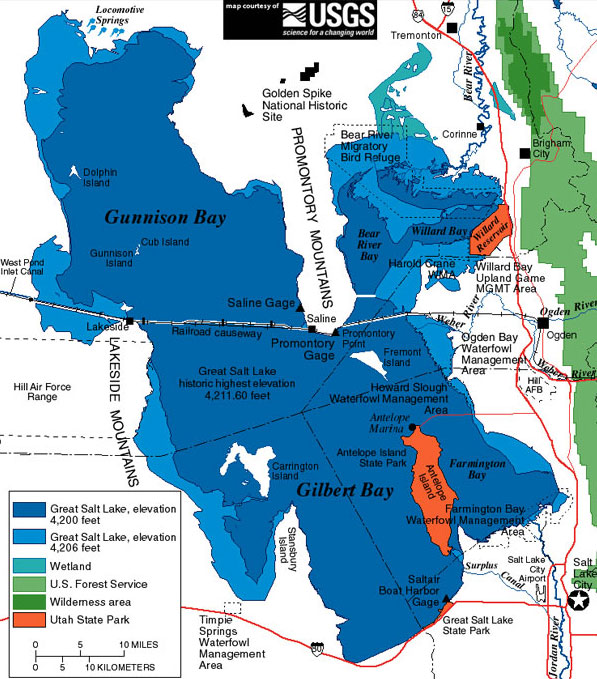 “I think people are waking up to the fact that it might go away,” Baxter said. One indicator is that more people are realizing the lake has individual importance — the scenery, depicted by amateur artists who now wistfully remember closer shores; hunters prowling the lake’s fringes for generations; workers who see their livelihoods potentially evaporating; sailboat owners whose craft sit idle, unable to launch because there’s not enough water; and so on.
“I think people are waking up to the fact that it might go away,” Baxter said. One indicator is that more people are realizing the lake has individual importance — the scenery, depicted by amateur artists who now wistfully remember closer shores; hunters prowling the lake’s fringes for generations; workers who see their livelihoods potentially evaporating; sailboat owners whose craft sit idle, unable to launch because there’s not enough water; and so on.
“I’m not a person that is prone to drama; I am motivated by the straightforward science,” Baxter said. “But I am seeing people moved by fear for the lake along the Wasatch Front. I am motivated by that.”
The lake, the eighth largest saline lake in the world, has an estimated $1.5 billion economic value and supports about 10 million waterbirds, of about 250 species.
A 2017 Utah State University study estimated than Utahns every year divert 3.3 trillion liters of water from the rivers and streams that feed the lake.
Baxter and others in academia have traced the Great Salt Lake’s natural and human history, hoping that their work will help to inform the ongoing conversation about the lake’s fate.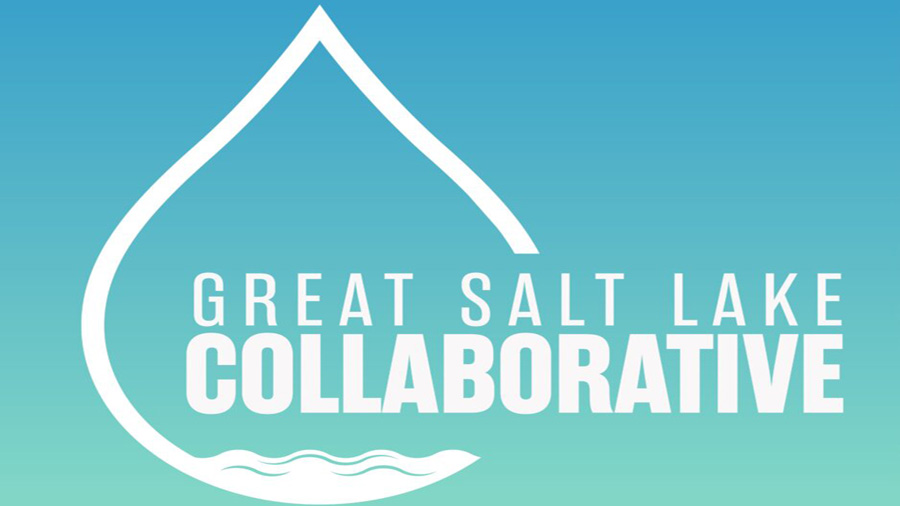
“We’ve done this experiment before,” Baxter said, referring to other terminal lakes, like the Aral Sea, that have shrunk by catastrophic degrees. “It starts with water diversions to feed people, to house people, and then you have a time of drought and the lakes are no longer able to bounce back.”
The Great Salt Lake’s geologic history shows a much larger view than the disappearance of the freshwater Lake Bonneville, which lost enormous volume about 15,000 years ago, its remnant being the current stressed saltwater lake. Baxter said that was only the most recent stupendous transformation — over the last 800,000 years, “large lake episodes have been the norm.” Water in the Bonneville basin over geologic time has risen and fallen repeatedly.
In her 2018 study “Great Salt Lake microbiology: a historical perspective,” Baxter describes humans’ impacts on the lake and how the body of water’s nature has been altered by upstream consumption, diversions such as Farmington Bay and Willard Bay, and industry.
Humans likely have been in Utah since the Pleistocene epoch, between 15,000 to 20,000 years ago, the high point of Lake Bonneville, according to Baxter’s manuscript, which in part draws upon the work of numerous scientists and historians.
Lake Bonneville would have given the region’s inhabitants an abundant source of freshwater fish. As the lake changed over time, humans would have moved in tune with the changing shorelines, hunting, fishing, and foraging.
The Fremont native peoples buried their dead during their time around the Great Salt Lake’s wetlands and along the Bear River in the period of 400 to 1000 AD, as shown by anthropology and archeology studies. The Shoshone and Utes lived on the lake’s north side and the Goshutes roamed along the lake’s southern reaches.
In 1824, explorer Jim Bridger floated down the Bear River and into the Great Salt Lake, claiming its modern discovery. But historians have reported that French-Canadian trapper Etienne Provost beat Bridger to the Great Salt Lake by a few months.
The John C. Fremont expedition in 1843 mapped and described the region’s topography, including the lake’s islands — one of which bears his name — and reported on its mineral and biological content. In 1849, civil engineer Howard Stansbury’s team conducted a wider study of the lake’s geography, natural history, minerals, and water chemistry. Stansbury also is immortalized by an island named after him.
The 1847 arrival of the pioneers of The Church of Jesus Christ of Latter-day Saints heralded what would become today’s significant population growth and associated human impacts on the lake.
The pioneers noted that the Salt Lake Valley’s geography paralleled the Holy Land’s in the Middle East. According to the church in a 1997 citation, the similarity generated a sense that Salt Lake was a land for a “chosen people, just as the Holy Land was seen as the promised land” in biblical times.
Mineral extraction, agriculture diversions, and shortcuts for the railroad eventually would affect the previously pristine lake as the settlement grew. Minerals obtained today are used for road and softener salt, magnesium chloride for steel production, and potassium sulfate for fertilizer.
Those industries diverted and dammed and created evaporation ponds. Other damming projects created vital bird habitats, but they too diverted water that before would have reached the lake.
The brine shrimp industry began booming in the 1970s, but increasing salinity in the shrinking lake threatens the enterprise. However, Baxter pointed to cooperation between the industry and the Utah Division of Wildlife Resources to ensure the lake is not overharvested.
With the combination of climate change and assorted human impacts, “Now we’ve got this lake set up to fail,” Baxter said. “But I’m really buoyed by what happened in the Legislature. It was unanimous, bipartisan. There was a lot of lake love going on. It was beautiful.”
She urged people to look at the array of reasons they should care about the lake. “If you don’t care about the migratory birds, you might care about what the dust will do to air quality. We all need to be doing not one thing, but everything we can do to value water getting into this lake.”
Church of Jesus Christ of Latter-day Saints removes mask requirement in temples
SALT LAKE CITY— The Church of Jesus Christ of Latter-day Saints announced that masks would no longer be required in temples Tuesday.
The church released a statement thanking members for their “patience during restricted temple operations that occurred because of the COVID-19 pandemic,” and expressed their eagerness to return the temples to full operation as soon as possible.
The statement reads, “Now that more people are immunized, we are pleased to announce that temples throughout the world will gradually return to more normal operations, including the elimination of face masks and capacity restrictions.
Based on local circumstances, the return to normal operations for each temple will be made by the temple presidencies and Area Presidencies in consultation with the Temple Department. Temple presidencies are invited to prepare plans to return temples to full capacity.”
The Church shared their gratitude for “the sacred work performed in temples,” stating, “We trust that our members will rejoice in the lessening of restrictions and will increase their commitment to temple and family history work.”
Church of Jesus Christ of Latter-day Saints’ historic sites returning to normal operations
SALT LAKE CITY — All historic sites of The Church of Jesus Christ of Latter-day Saints are returning to normal operations.
Church officials made the announcement Tuesday afternoon. Among the sites returning to normal operations are five in Utah: the Beehive House, in Salt Lake City; Cove Fort, in central Utah; and the Brigham Young Winter Home, St. George Tabernacle and Hamblin Home in southern Utah.
The Church also operates historic sites in New York, Pennsylvania, Vermont, Ohio, Missouri, Illinois, Iowa, Nebraska and Wyoming.
In many parts of the world, the Church of Jesus Christ continues to lift COVID-19 restrictions. This now includes all Church historic sites, which are returning to normal operations. Visit the link for more information about each location.https://t.co/jElIPHwwXD
— The Church of Jesus Christ of Latter-day Saints (@Ch_JesusChrist) March 1, 2022
Among other Church functions that have begun or completed phases of reopening include Deseret Industry stores, which are open and patrons can make unscheduled donations; the Family History Library, which has expanded its days of operation; and Church distribution retail stores and Deseret Book locations, which are following local government and health official guidelines.
Youth camps, conferences and treks, and pageants remain postponed or closed to the public. The Tabernacle Choir at Temple Square is gradually returning to its schedule of rehearsals and broadcasts with a COVID-19 protocol plan in place, but audiences are not invited to join them at this time.
Family History Library extending hours in Salt Lake City
SALT LAKE CITY — The FamilySearch Family History Library in Salt Lake City is adding additional hours to its schedule as it moves into Phase 2 reopening plans.
The change is all part of the phased reopening of Temple Square, which is owned by The Church of Jesus Christ of Latter-day Saints.
According to Church officials, the library will be adding Saturdays to their normal operating hours beginning Nov. 6.
That means the Family History Library, located on 35 North and West Temple Street, will now be open to the public Monday through Saturday from 9 a.m. to 5 p.m.
“No reservations needed unless group is over 20 or a room is required,” read the FamilySearch website.
Beginning November 6, 2021, the Family History Library on Temple Square will expand its days of operation to include Saturdays from 9 a.m. to 5 p.m. @FamilySearchhttps://t.co/AfhGPcdmaL
— The Church of Jesus Christ of Latter-day Saints (@Ch_JesusChrist) November 1, 2021
Officials said the library is tentatively scheduled to open from 6 p.m. to 8 p.m. on Tuesday and Wednesday, but by appointment only.
“Evening access will be limited to main floor services unless otherwise requested. Individuals, and youth, church, and genealogical groups will be able to make appointments,” the website stated.
That change is scheduled to take effect the week of Nov. 15.
Details about the other buildings open to visitors in Temple Square can be viewed here.
Salt Lake City Could Make History By Electing Its First Latina Mayor
(CNN) — As a high school graduate, Luz Escamilla moved to Salt Lake City from Mexico seeking the American dream. She wanted to become an entrepreneur, but seeing students of color struggle pushed her to do more.
Now, she’s running to become the city’s first Latina mayor.
Escamilla, 41, has spent the last weeks of her campaign facing her opponent in numerous debates, responding to questions about her faith and knocking on doors in the city’s west side — a traditionally underrepresented area that she calls home.
“It wasn’t planned at all,” Escamilla said about her career in politics. “I needed to react according to the needs that I was facing in my community.”
She learned about those needs while serving as a Democratic state senator in Utah for more than a decade and by helping small businesses as an executive for Utah-based Zions Bank. Escamilla has championed minorities since her student days at the University of Utah, when she realized she was the only person with black hair sitting in a freshman philosophy class. She tutored immigrant students in English.
“I was learning how many disparities there were, how much the ZIP code where you were living was determining the abilities of a child to succeed in school or not,” Escamilla said. “I started thinking, ‘This is not okay, what can I do to change that?”
Latinos are the largest minority in the state and they are 20% of Salt Lake City’s roughly 200,000 residents, according to the latest US Census statistics. Other Latinas are involved in state and local politics, but none has led Utah’s capital city.
She and her opponent, Salt Lake City Councilwoman Erin Mendenhall, 39, are both Democrats. They were the top candidates who moved to the general election after the primary in August. The state is largely dominated by Republicans but the city has elected Democratic mayors for decades.
Mendenhall has extensive experience in city government and has a similar platform than Escamilla.
The first Mexican immigrant elected state senator
Escamilla was born in Mexico City but her family moved around the country before settling in the border city of Tijuana. Her parents, both engineers, showed her since an early age that getting an education was a priority.
For two years, Escamilla and her brother crossed the border every day to attend high school in San Diego. When she graduated, she moved to Salt Lake City to attend the University of Utah. She hardly knew anyone and she missed her family, but she knew she had to stay focused.
“I really felt this sense of responsibility,” Escamilla said. “My parents were working hard to give me this opportunity.”
She had her mind set on becoming a business owner and maybe returning to the US-Mexico border. But she fell in love with the city and became involved with advocacy.
Over the past 22 years, Escamilla became a US citizen and worked in the non-profit sector and as a health policy analyst before fully turning her eyes to governance.
After earning her master’s degree in public administration and leading the state’s Office of Ethnic Affairs, she was elected to the Utah state senate in 2008. She was the first Latina and the first immigrant in the state’s senate.
Olga de la Cruz, an entrepreneur and former mayor candidate in nearby Midvale City, said that historically few Latinos have sought public office in Utah.
“She is already breaking a lot of barriers and continues to be a role model for other Latinos considering to run for office,” she said.
She doesn’t want her religion to take center stage
A more personal side of Escamilla has been put into question during her campaign: her faith.
Escamilla, who is married and has six children between her and her husband, is member of The Church of Jesus Christ of Latter-day Saints. In recent months, critics have suggested her decisions could be influenced by faith leaders. The church is headquartered in Salt Lake City.
Former Salt Lake City Mayor Rocky Anderson, in a Facebook post n August, said Escamilla seemed “willing to do the bidding of the church, the developers, and the bank where she has been employed.”
Escamilla has dismissed the attacks, saying that she has “voted for and against bills contrary to the LDS Church’s position” during her time as a state senator.
“I have always been and will always be an independent voice for the people I represent,” she wrote in a blog post addressing the criticism.
More than three decades have passed since the city had a mayor who belonged to the church. Mayor Ted Wilson, also a Democrat, served from 1976 to 1985.
One of her top issues is clean air
Escamilla said there’s not enough collaboration between local and state officials in key issues for the city, but she’s confident she can build consensus.
If elected, she wants to address issues like affordable housing, sustainability and improving air quality. She hopes that her vision combined with her experience in the Legislature will resonate across Salt Lake City.
Many of Escamilla’s priorities are focused on building a better future for the city and its younger residents.
“My 3-year-old has asthma and I developed asthma in the past five years. It’s pretty personal when you see your children sick,” Escamilla said.
Her daughter has been forced to take medication during the winter months and sometimes struggles with a cough when she runs.
To reduce air pollution, Escamilla is focusing on transportation. She’s pushing for more mass transit usage, alternative modes of transportation and making neighborhoods more walkable.
“I want (my daughter) to have the quality of life that I’ve enjoyed in Salt Lake City, ” Escamilla said, “and I’m fighting hard to improve the air quality for her.”
AUCKLAND, New Zealand — A former Brigham Young University student is putting high-tech into the world of ancient history by mixing a little magic, art, culture and technology.
The creation may seem like something out of “Harry Potter” — where the artwork comes alive and talks to people.
But that’s exactly what Jesse Armstrong is creating with his storytelling tech company Vaka Interactive.
Armstrong said that it’s all about bringing stories to life through the talking artwork.
His goal is to bring new life to museums who are wanting people to linger longer.
“We develop storytelling technology for museums, art galleries and others to bring stories to life to truly awaken the power of a story,” Armstrong said.
Armstrong and his team got the idea after sitting at a museum observing people for hours.
“We realized very quickly because there was a lack of storytelling in that space to connect people with an understanding of what they were looking at,” he said.
Jesse is a former BYU student who dropped out of college to pursue his dream in his hometown of Auckland, New Zealand. KSL’s Dan Rascon caught up with him during his trip to the South Pacific Islands covering President Russel M. Nelson’s ministry tour with members of The Church of Jesus Christ of Latter-day Saints.
“I love it. Every single day I wake up and it’s the first thing I think about,” Armstrong said about his tech company.
The process is not an easy one — in fact, it is years in the making. The team can either bring to live a historical figure on canvas or put a living person on the screen.
“For example, if we use a person living today we can bring them in, scan them in 3D and effectively use software to make that 3D model of them look like a painted figure and bring that figure to life and make them talk,” Armstrong said.
The other idea they are working on is to have a virtual tour guide which would have the person jump from portrait to portrait, following visitors to talk to them about what they are seeing.
Armstrong’s ultimate dream is to one day get the portrait to have a two-way conversation with people. Right now he’s working with several prestigious museums in his country to get his business up and running.
“My team and I, we are totally sold on what we are doing,” he said.
SALT LAKE CITY, Utah – The 189th Annual General Conference for The Church of Jesus Christ of Latter-day Saints wrapped up today after a weekend of messages to its members.
In the afternoon session of Conference, Church President Russell M. Nelson announced new renovations to historic temples and new temples to be built.
President Nelson said the Salt Lake Temple along with Temple Square and the surrounding area will undergo renovations. He said the St. George Temple, Manti Temple, and Logan Temple will also be renovated.
Plans for of the Salt Lake Temple, Temple Square, and the adjoining plaza near the Church Office Building will be announced on Friday, April 19, 2019, according to President Nelson.
The work will require each temple be closed for a period of time, and then rededicated once the renovations are finished.
“Ours is a sacred responsibility to care for them. Therefore, these pioneer temples will soon undergo a period of renewal and refreshing, and, for some, a major restoration. Efforts will be made to preserve the unique historicity of each temple wherever possible, preserving the inspiring beauty and unique craftsmanship of generations long-since passed,” President Nelson said.
Before announcing the new temples, President Nelson asked the attendees to listen “carefully and reverently”.
“Brothers and sisters, we regard a temple as the most sacred structure in the Church. Aswe announce plans to construct a new temple, it becomes part of our sacred history,” President Nelson said.
The new temples will be built in Pagopago, American Samoa; Okinawa City, Okinawa; Neiafu, Tonga; Tooele Valley, Utah; Moses Lake, Washington; San Pedro Sula, Honduras; Budapest, Hungary; and Antofagasta, Chile.
SALT LAKE CITY, Utah – Tens of thousands of people will be attending the April 2019 General Conference of The Church of Jesus Christ of Latter-day Saints, and millions more will be watching from around the globe.
The morning session begins at 10 a.m., and the afternoon session begins at 2 p.m. Watch on KSL 5 TV, at KSLTV.com, or on the KSLTV app.
This article will be updated throughout Saturday’s morning and afternoon sessions. Updates are in chronological order, so the newest additions will be at the bottom. Refresh for the latest news.
SATURDAY MORNING SESSION
Elder Ulisses Soares: Teachings Will Transform Hearts
Elder Ulisses Soares of the Quorum of the Twelve Apostles was the first to the podium, speaking on the desire to learn knowledge and increase faith.
He said striving to learn from and live like Jesus Christ will bring a happier, healthier life.
That includes compassion for those who have left the Church, Soares said.
“Be their friends and look for the good in them,” he said. “Never reject or misjudge them. Just love.”
“It is hard to understand all the reasons why some people take another path. The best we can do in these circumstances is just to love and embrace them.” #ElderSoares | #GeneralConference
— GeneralConference (@ldsconf) April 6, 2019
Sister Becky Craven: Are You Careful Or Casual?
Sister Becky Craven, Second Counselor of the Young Women General Presidency, spoke about being careful or casual in the path to righteousness.
The world is full of distractions, Craven said, and members of The Church of Jesus Christ of Latter-day Saints need to ask themselves if they are careful or casual when it comes to their standards.
Can happiness be bought with $15.00? No, it can’t. Deep and lasting happiness comes by intentionally and carefully living the gospel of Jesus Christ.
—#SisterCraven #GeneralConference— The Church of Jesus Christ of Latter-day Saints (@ChurchNewsroom) April 6, 2019
“There is not a right way to do the wrong thing,” she said.
She noted members need to keep their covenants as they live their lives, but don’t judge those who are on the same journey.
Elder Brook P. Hales: Answered Prayers
Elder Brook P. Hales of the Seventy shared stories about how the faithful, who adhere to their covenants, are privy to divine guidance through the Holy Ghost.
Hales gave examples of how prayers are answered, often in ways unseen. He said the Lord answers prayers perfectly in his infinite wisdom to the divine benefit of the person, whether that person realizes it or not.
Elder Hales: A friend, Patricia Parkinson, went blind at age 11. She has felt depression and sadness, but if asked if she is angry says: “Who would I be angry with? Heavenly Father is in this with me; I am not alone. He is with me all the time.” #generalconference #latterdaysaint
— Tad Walch (@Tad_Walch) April 6, 2019
Elder Dieter F. Uchtdorf: Share Your Faith With Others
Dieter F. Uchtdorf Quorum of the Twelve Apostles began his talk by noting that the number of Christians around the world is shrinking, and fewer people are receiving the light of God.
He offered five steps to take to successfully share the gospel in daily life:
- Draw close to God.
- Fill your heart with love for others.
- Strive to walk the path of discipleship.
- Share what is in your heart.
- Trust the Lord to work his miracles.
“Heavenly Father knows you,” he said. “The Lord loves you. God will bless you. This work is ordained of Him. You can do this. We can all do this together.”
“Remember, the Lord has never required expert, flawless missionary efforts. Instead, the Lord requires the heart and a willing mind.” #ElderUchtdorf | #GeneralConference
— GeneralConference (@ldsconf) April 6, 2019
Bishop W. Christopher Waddell: Ministering To Those In Need
Bishop W. Christopher Waddell, second counselor in the Presiding Bishopric of The Church of Jesus Christ of Latter-day Saints, began with a story about his brother, who died of cancer, who found his way back to the Church before he died.
“It isn’t necessary for someone to be suffering, like my brother, from a life-threatening disease in order to be in need of ministering service,” he said. “Those needs come in a variety of shapes, sizes and conditions.”
He said that “no one is too far gone” to receive the Savior’s loving reach.
“In modeling our ministering after Jesus Christ, it is important to remember that his efforts to love, to lift, to serve and bless had a higher goal than meeting the immediate need.” #BishopWaddell | #GeneralConference
— GeneralConference (@ldsconf) April 6, 2019
President Henry B. Eyring: Invite the Spirit Into the Family
President Henry B. Eyring, Second Counselor of the First Presidency, spoke about building faith in Jesus Christ and how that will reverse spiritual decline in families.
It’s that faith that is more likely to bring repentance than preaching against the symptoms of spiritual decline, he said.
“The pure love of Christ must come into the hearts of those in our family,” Eyring said.
“Because none of us is perfect and feelings are easily hurt, families can become sacred sanctuaries only as we repent early and sincerely.” #PresidentEyring | #GeneralConference
— GeneralConference (@ldsconf) April 6, 2019
SATURDAY AFTERNOON SESSION
President M. Russell Ballard: Live the Teachings of Christ
M. Russell Ballard, President of the Quorum of the Twelve Apostles, reminded members that God wants His children to have peace and happiness. That peace and happiness can be found through serving the Lord and our neighbors.
"Brothers and sisters, do the best you can do day after day, and before you know it, you will come to realize that your Heavenly Father knows you and that He loves you."#MRussellBallard #GeneralConference #GenConf #ElderBallard
— BYU-Idaho Scroll 🗞 (@byuiscroll) April 6, 2019
“We minister because we love our Heavenly Father and His children,” Ballard said.
He added that ministering efforts will be successful if the ministering is kept simple.
Elder Mathias Held: Find Truth Through the Rational Mind and Still Small Voice
Elder Mathias Held of the Seventy spoke of receiving light and understanding through both logical reasoning and through the Holy Ghost.
Held compared rational logic and the Still Small Voice to the left and right eyes — using both eyes together give the “true and complete picture.”
“Through the gift of the Holy Ghost, the Father has also provided us with a second perspective, which is really the most important and true one because it comes directly from Him.” #ElderHeld | #GeneralConference pic.twitter.com/Fxwc8xdmTC
— GeneralConference (@ldsconf) April 6, 2019
Elder Neil L. Andersen: Perspective of Truth
Elder Neil L. Andersen, of the Quorum of the Twelve Apostles, noted that there are universal truths that are the same for everyone.
Some truths, he said, humans may not understand because they don’t have the correct perspective.
Andersen spoke of the Proclamation to the World and how members can’t pick and choose which parts of it they accept based on their single perspective.
“If we pick and choose what we accept in the Proclamation, we cloud our eternal view, putting too much importance on our experience here and now.” #ElderAndersen | #GeneralConference pic.twitter.com/vLOW98ldst
— GeneralConference (@ldsconf) April 6, 2019
Elder Takashi Wada: Spiritual Feast
The words of Christ are a feast, said Elder Takashi Wada of the Seventy.
Like a feast of food, feasting on the scriptures should bring joy, he said.
“The words of Christ can help us increase our spiritual capacity to receive revelation and safely guide us through life,” Wada said.
He spoke of the “pleasing word of God in the scriptures” that helps give us strength and know who we are.
“The words of Christ will profoundly touch hearts and open the hearts of those who do not yet see him.” #ElderWada | #GeneralConference pic.twitter.com/gAwW9CtK01
— GeneralConference (@ldsconf) April 6, 2019
Elder David P. Homer: Which Voice Guides Us?
David P. Homer of the Seventy noted that there are many voices saying many things in this day and age, and it can be difficult filtering those voices and choosing which to obey.
“If we are not careful, the wrong voices can draw us away from the gospel center to places where faith is difficult to sustain, and we find little more than emptiness, bitterness and dissatisfaction.” #ElderHomer | #GeneralConference pic.twitter.com/gZ7IMdpO1V
— GeneralConference (@ldsconf) April 6, 2019
Homer said that the more diligently His children seek His voice, the easier it is for them to hear the Lord.
Heavenly Father’s voice can be found in prayer, scripture study, church, faithful discussions and in the temple.
Elder Jeffrey R. Holland: The Importance of Sacrament Meeting
Beginning with the ancient sacrifice of the lambs commanded to Adam and Eve, Elder Jeffrey R. Holland, of the Quorum of the Twelve Apostles, told of the evolution of the sacrament and what it means today.
He said the modified Church schedule is to put an emphasis on the importance of the sacrament.
Holland called for the sacred hour to be an hour of punctuality and peace, with a focus on the sacrament. He advised congregation members and church leaders alike refrain from actions that might detract from sacrament meeting.
“We make an apostolic plea for the reduction of clamor in the sanctuary of our buildings.” #ElderHolland | #GeneralConference
— GeneralConference (@ldsconf) April 6, 2019
“This hour ordained of the Lord is the most sacred hour of our week,” he said.
____________________________________________________________________________________________________________________________________
SUNDAY MORNING SESSION
Elder Dale G. Renlund: Abound With Blessings
We should liken heavenly blessings to a huge pile of wood, said Elder Renlund of the Quorum of the Twelve Apostles said . Kindling, sticks, small logs, and huge logs contain an enormous amount of fuel. Envision a single match with a phosphorus tip. The match needs to be struck, and the kindling lit. The kindling will catch fire and cause the other pieces to burn. It continues until all the pile is burned. Until the match is struck, nothing happens, regardless of the size of the wood pile. In a similar way, most blessings require action on our part. That action is faith in the Lord, Jesus Christ. The required action is always tiny when compared with the blessings received. “We must act on our faith in the Lord, Jesus Christ to be blessed,” he said. You don’t earn a blessing. But you do have to qualify for it. Our salvation comes only through Jesus Christ.
“The activation energy needed for us is to have enough faith in Christ to sincerely ask God in prayer and accept His will and timing for the answer.” #ElderRenlund | #GeneralConference pic.twitter.com/PDbeyEkDZd
— GeneralConference (@ldsconf) April 7, 2019
One of the objects of prayer is to secure blessings God is willing to grant, but depends on our willingness to ask, Renlund said. “I invite you to faithfully activate heavenly power to receive specific blessings from God. Exercise faith to strike the match and light the fire. Supply the needed oxygen while you patiently wait on the Lord.”
Sister Sharon Eubank: Christ the Light that Shines in Darkness
Jesus Christ is the life and light of the world, without a strong connection, we spiritually die, said Sister Sharon Eubank, first counselor in the general presidency of the Relief Society. Satan works to dim our light, leaving us alone in the dark. Satan works to isolate us and tell us we’re the only ones experiencing them. “I know many of you run very, very fast,” she said. “Part of out life experience is knowing what not to do… Christ is rest.” Some of us feel like we don’t fit the mold, she said. Christ reached out to people who weren’t traditionally accepted in society. “It’s an unwavering requirement of Christian disciples and Latter-day Saints to show true love to one another.” Some of us feel that we can never be good enough. “The miracle of His grace is that when we repent of our sins, His scarlet blood returns us to purity.”
“The miracle of His grace is that when we repent of our sins, His scarlet blood returns us to purity.” #SisterEubank | #GeneralConference pic.twitter.com/mr0I7qC4Qv
— GeneralConference (@ldsconf) April 7, 2019
The key is to make and keep sacred covenants. Make Christ the center of your life, Eubank said. Turn to Jesus Christ who loves you still.
Elder Quentin L. Cook: Great Love For Our Father’s Children
Elder Quentin L. Cook of the Quorum of the Twelve Apostles said this is a unique time in history before the Second Coming of the Savior. Charity includes God’s eternal love for all of his children. “Love of the Savior and love our fellow men and women is the primary attribute and motive for ministering and the spiritual purposes we were charged to undertake by our beloved prophet,” he said. Love was essential to missionary work in our day, just as it has always been. Most missionaries feel this kind of love, and when they do, their efforts are blessed. When it comes to gathering Israel we need to be motivated by love, Cook said. “What is needed is a loving, compassionate, spiritual commitment by each of us men, women, youth and children to share the gospel of Jesus Christ,” he said. If we show love, kindness and humility, many will accept our invitations.
“What is needed is a loving, compassionate, spiritual commitment by each of us men, women, youth and children to share the gospel of Jesus Christ.” #ElderCook | #GeneralConference
— GeneralConference (@ldsconf) April 7, 2019
Lovingly performing ordinances for ancestors will protect youth and families, he said. Make social media a servant, not a master. As parents we need to make sure media content is wholesome and age appropriate.
Elder D. Todd Christofferson: Prepare for the Second Coming of the Lord
“The Resurrection confirms the divinity of Jesus Christ and the reality of God, the father. Our thoughts turn to the Savior and we ponder … the infinite virtue of His great atoning sacrifice,”said Elder D. Todd Christofferson of the Quorum of the Twelve Apostles. “I hope we also anticipate his return.” Let us do all we can to relieve suffering now, and to the preparations when Christ shall rein personally upon the Earth. “It will be a day of redemption and judgement,” he said. “Crucial for the Lord’s return is the presence on the earth of a people prepared to receive Him at His coming.”
“The Spirit made clear to me that The Church of Jesus Christ of Latter-day Saints is uniquely empowered and commissioned to accomplish the necessary preparations for the Lord’s Second Coming. Indeed, it was restored for that purpose.” #ElderChristofferson | #GeneralConference pic.twitter.com/ImIjqt6JFh
— GeneralConference (@ldsconf) April 7, 2019
Unity, godliness and charity built up Zion. We want to know about the Lord, and we want to know the Lord, Christofferson said. “It is the Lord’s work, and He is doing it.”
Elder Tad R. Callister: The Atonement of Jesus Christ
The atonement of Christ is a series of events, said Elder Tad R. Callister, general president of the Sunday School. The Savior overcame death with his glorious resurrection. He overcame sin for all those who repent. “It is an infinite Atonement because it encompasses and circumscribes every sin and weakness, as well as every abuse or pain caused by others.” If we feel the spirit, that is our witness that we have been forgiven, or the cleansing power is taking place. The memory of guilt can be a warning, he said. “It serves as a protection, not a punishment.” When we repent we are born of God. “I am a new, and transformed being.” The Savior can take away or give strength in afflictions.
“The Savior’s Atonement gives us life for death, beauty for ashes, healing for hurt and perfection for weakness. It is heaven’s antidote to the obstacles and struggles of this world.” #BrotherCallister | #GeneralConference
— GeneralConference (@ldsconf) April 7, 2019
President Russell M. Nelson: “Come, Follow Me”
President of the Church of Jesus Christ of Latter-day Saints Russell M. Nelson spoke about his last conversation with his daughter before her death. “You have brought me much joy,” he told her. “We miss our daughter greatly. However, because of the restored gospel of Jesus Christ, we do not worry about her … Meanwhile, we’re serving the Lord here and she is serving Him there, in paradise.” President Nelson spoke about death. “In that coming day, when you will complete your mortal probation and enter the spirit world, you will be brought face-to-faith with a heart-wrenching question, Where is my family?” Salvation is an individual matter, but exaltation is a family matter, he said. We qualify by making and keeping covenants with God, President Nelson said.
“Ever since Adam and Eve were expelled from the Garden of Eden, Jesus the Christ has offered His might arm to help all who choose to follow Him.” #PresidentNelson | #GeneralConference pic.twitter.com/TbbUsGgzXJ
— GeneralConference (@ldsconf) April 7, 2019
The Savior invites all to follow him to the waters of baptism, and to the temple for sacred ordinances, he said. All of these are required to be together as a family, said President Nelson. “The anguish of my heart is that many people whom I love, whom I admire and respect, decline His invitation. They ignore the pleadings of Jesus Christ when he beckons, ‘Come, follow me.’” Pour out your heart to God, he said, ask him if these things are true. “If you truly love your family…pay the price now through serious study and fervent prayer to know these eternal truths, and then to abide by them.” Put yourself in a position to have experiences with God. “Jesus Christ invites us to take the covenant path back to our Heavenly Parents.”
“Do the spiritual work to find out for yourselves, and please do it now. Time is running out.”
SUNDAY AFTERNOON SESSION
President Dallin H. Oaks
Sins can be forgiven because of the Atonement, said President Dallin H. Oaks, First Counselor in the First Presidency. The atonement opens the door for all men to repent.
My message is one of hope for all of us, he said. “We are all sinners who can be cleansed by repentance.” He described repentance as a joy, not a burden. It is a never-ending privilege, he said. Man cannot be saved without repentance.
As we love god with all our might, mind, and strength, then we may be perfect in Christ. “What a promise! What a miracle! What a blessing!”
The scriptures describe the final judgment. “All things should be restored to their proper order.” We must repent before the final judgment. “God love us, and we can be cleansed of our sins.”
“When we repent, we have the Lord’s assurance that our sins, including our acts and desires, will be cleansed, and our merciful final judge will remember them no more.” #PresidentOaks | #GeneralConference pic.twitter.com/OnSWsZexL0
— GeneralConference (@ldsconf) April 7, 2019
Elder Juan Pablo Villar: Exercising Our Spiritual Gifts
Elder Jaun Pabol Villar of the Quorum of the Seventy, said spiritual muscles need to be exercised to grow. Principles of action need exercise.
He shared a story about visiting his brother on his mission before he was a member of the Church. His brother took him on all of his appointments that day, and it taught him the Gospel. Months later, he was baptized and served a mission.
“He helped me to accept the invitation of the Master, ‘Come Follow Me,'” he said.
“When doubts come to our minds, trusting in the Lord’s promises will be required to move forward.” #ElderVillar | #GeneralConference pic.twitter.com/7t6FaSBNnB
— GeneralConference (@ldsconf) April 7, 2019
“If we want to increase our faith, then let’s do things that require faith,” Villar said.
Elder Gerrit W. Gong
Elder Gerrit W. Gong of the Quorum of the Twelve spoke about the Good Shepherd, who is also the Lamb of God. “Who better to be our Good Shepherd than the Lamb of God?”
Jesus had power to lay down his life, and power to take it up again. Jesus Christ calls us in his voice, and his name. He teaches us how to minister and love.
“Our Savior reaches out to the one and to the ninety-and-nine, often at the same time,” he said.
“God’s shepherds are to strengthen, heal, bind up that which is broken, bring again that which was driven away, seek that which was lost.” #ElderGong | #GeneralConference pic.twitter.com/eymZ5RpliO
— GeneralConference (@ldsconf) April 7, 2019
“Today, our Savior desires that what we do and who we are becoming will invite others to come follow Him.”
Elder David A. Bednar: Prepared to Receive Every Needful Thing
We should ask in our church meetings what we learned in our homes, said Elder David A. Bednar of the Quorum of the Twelve Apostles. Our personal responsibility is to learn what we need to learn, and to become who the Master would have us become. Our homes are the ultimate setting for learning, living, and becoming.
“The ultimate responsibility for developing spiritual strength and stamina rests upon each one of us,” he said.
He said each individual needs to gain knowledge for himself or herself. “We cannot rely exclusively upon or borrow gospel light and knowledge from other people — even those whom we love and trust.”
Because we love the Lord, we always should speak about his Holy House with reverence. The temple is the house of the Lord. Everything points us to our Savior, Jesus Christ, he said.
“I joyfully witness that compensating blessings will come as we strive to fulfill our individual responsibility to learn and love the restored gospel of Jesus Christ. We truly can be prepared to obtain every needful thing.” #ElderBednar | #GeneralConference pic.twitter.com/l4tpD1wG9J
— GeneralConference (@ldsconf) April 7, 2019
Elder Kyle S. McKay: The Immediate Goodness of God
The Lord’s timing is different than ours. Patience is key, Elder Kyle S. McKay of the Seventy said.
“The immediate goodness of God comes to all who call upon Him with real intent. … This includes those who cry out in earnest desperation when deliverance seems so distant and suffering prolonged,” he said.
He shared the story who overcame addiction through prayer and the spirit. He also shared a story about a mother who lost a son in a snowmobile accident, and was strengthened by a Priesthood blessing, and by the spirit.
“Our mere preservation is a tender and powerful manifestation of the immediate goodness of God.” #ElderMcKay | #GeneralConference pic.twitter.com/8RSWot3tkZ
— GeneralConference (@ldsconf) April 7, 2019
Elder Ronald A. Rasband: Build a Fortress of Spirituality and Protection
Elder Ronald A. Rasband of the Quorum of the Twelve Apostles encouraged participants to go home and ponder the words heard in General Conference.
“Our homes are fortresses against the evils of the world,” he said.
Remember, our homes are only as powerful as the spiritual strength of each one of us within the walls, he said. “We are at war with Satan for the souls of men.”
“When we build a fortress of spiritual strength, we can shun the advances of the adversary, turn our backs on him, and feel the peace of the Spirit,” Rasband said.
“Our testimonies of the gospel of Jesus Christ, our homes, our families, and our membership … will be our personal fortresses of protection surrounding us and shielding us from the power of the evil one.” #ElderRasband | #GeneralConference pic.twitter.com/AS7Tv9xbxt
— GeneralConference (@ldsconf) April 7, 2019
We should have integrity in all that we do. As we strengthen our fortifications, we become like Jesus Christ.
President Russell M. Nelson
We have 162 temples, Nelson said. Early temples are a crowning jewel of pioneer achievement. These pioneer temples will go through a period of renewal and refreshing, and for some a major restoration. We regard a temple as the most sacred structure in the church.
New temple sites announced:
Pago Pago, American Samoa
Okinawa City Neiafu, Tonga
Tooele Valley, Utah
Moses Lake, Washington
San Pedrosula, Honduras
Antofagasta, Chile
Budapest, Hungary
8 temples announced by President Nelson, plus renovations of all Pioneer-era temples.
Pago Pago, American Samoa
Okinawa City
Neiafu Tonga
Tooele Valley Utah
Moses Lake Washington
San Pedrosula Honduras
Antofagasta, Chile
Budapest, Hungary #GeneralConference— GeneralConference (@ldsconf) April 7, 2019
SALT LAKE CITY, Utah – The 189th Annual General Conference for The Church of Jesus Christ of Latter-day Saints is happening Saturday and Sunday.
KSL 5 TV has a full two days of documentaries that are airing between sessions of Conference. We will be airing these on television, on the KSL TV app and streaming on staging.ksltv.com.
Here is the two-day programming guide.
Saturday April 6, 2019
9:30 a.m. to 10:00 a.m. – History of the Saints: The Mary Fielding Story
10:00 a.m. to 12:00 p.m. – 189th Annual morning session of General Conference
12:00 to 12:30 p.m. – Service and Sacrifice: The Brent Taylor Story
12:30 p.m. to 1:30 p.m. – World Report
1:30 p.m. to 2:00 p.m. – Return to the Other Side of Heaven
2:00 p.m. to 4:00 p.m. – 189th Annual afternoon session General Conference
4:00 to 5:00 p.m. – A Site to See: Behind the Scenes at Temple Square
Sunday April 7, 2019
 9:00 a.m. to 9:30 a.m. – Rising Generation
9:00 a.m. to 9:30 a.m. – Rising Generation
9:30 a.m. to 10:00 a.m. – Music and the Spoken Word
10:00 a.m. to 12:00 p.m. – 189th Annual session General Conference
12:00 p.m. to 1:00 p.m. – Rome Italy Temple: A New Light in the Eternal City
1:00 p.m. to 1:30 p.m. – Go Forth
1:30 p.m. to 2:00 p.m. – Amish Latter-day Saints: A Journey of Discovery
2:00 p.m. to 4:00 p.m. – 189th Annual afternoon session of General Conference
4:00 p.m. to 4:30 p.m. – Kids in Kenya
4:30 p.m. to 5 p.m. – Lost in India



